Fantasy Books
Book Review: The Gate of the Feral Gods by Matt Dinniman
I received a review copy from the publisher. This does not affect the contents of my review and all opinions are my own.
 The Gate of the Feral Gods by Matt Dinniman
The Gate of the Feral Gods by Matt Dinniman
Mogsy’s Rating: 5 of 5 stars
Genre: Fantasy, Science Fiction
Series: Book 4 of Dungeon Crawler Carl
Publisher: Ace (March 11, 2025)
Length: 608 pages
Author Information: Website
There’s LitRPG, and then there’s Dungeon Crawler Carl. In fact, Matt Dinniman may have forever ruined this genre for me, as I don’t think I’ll ever find a series as fun and amazing. The Gate of the Feral Gods is the fourth installment, but there’s no slowing down here. Instead, we’re charging full steam ahead, plunging deeper into the chaos!
The story picks right up from where things left off in The Dungeon Anarchist’s Cookbook, joining Carl and his larger-than-life feline companion, Princess Donut, as they descend deeper into the dungeon in their continued fight for survival. Now on the fifth floor, the rules shift dramatically, presenting an entirely new set of challenges. This level introduces a unique twist: all crawlers are separated into individual biome-themed “bubbles” which are scattered across four quadrants of the game world. Unfortunately for Carl and Donut, this means being cut off from their friends, and to make matters worse, they won’t be able to access the next floor until all the objectives in their bubble are met. As this is not something they can do on their own, success hinges upon finding new allies—and fast.
By now, we’re starting to see a pattern emerge, with each level introducing a distinct gaming mechanic. In many ways, the fifth floor mirrors an epic game of Capture the Flag, in which crawlers are randomly assigned to the different bubbles, such as air, water, land, and deep ocean. Each biome also features their own set of dangers, mobs, and goals. The only way to break free is to destroy the castles in their respective bubbles, which would then allow crawlers to assist others in doing the same. But of course, Carl, Donut, and their new party member Katia have landed in one of the toughest bubbles, where the challenges are more difficult and the odds against them are stacked higher than ever. Still, as we all know, it will take much more than that to break their spirit.
The Gate of the Feral Gods was yet another fantastic sequel, and I just love cracking open each book to discover what awesome adventure awaits us next. What makes these books so addictive and so entertaining is the way each volume builds upon the ones that came before, driving up the excitement while still maintaining the humor, heart, and thrilling action. These books are laugh-out-loud funny, and I’m always surprised at Carl’s ingenious solutions to seemingly impossible situations. I’m also floored by the sheer creativity in everything from small-scale puzzles in the dungeon to the overarching intrigue of who or what in the great wide universe is actually in control of the crawl.
It’s honestly impressive how Dinniman can manage to juggle so many moving pieces of the storyline all at once. You’ve got multiple character arcs unfolding simultaneously, all their interconnected plotlines, a dungeon and its AI that are constantly shifting in new and unexpected ways, various RPG mechanics that are expanding as the characters get stronger, plus an intergalactic political drama playing out in the background to boot! Whew! With so much happening at once, one thing for sure is that you’ll never be bored, and what’s more, each storyline is given the time and attention it deserves. True, sometimes things can feel a little overwhelming, but so far, the author seems quite diligent in resolving story threads so that readers aren’t left hanging.
But truly, what sets Dungeon Crawler Carl apart is its character development. Yes, we get new quest lines, new boss fights, and plenty of the crazy-ass dungeon-crawling mayhem that can only come from the mind of Matt Dinniman, but we also get to see Carl and Donut’s relationships evolve—both with each other and with the ever-expanding cast of allies and adversaries. In some ways, this series has the feel of a favorite soap opera, where I just can’t wait to dive back in to catch up with all the characters.
That said, things get pretty bleak for some of them. It’s a sad fact that none of the side characters are truly safe, and even Carl and Donut get put through the wringer, as they adapt to increasingly cruel and brutal challenges. Our protagonist has repeatedly sworn that the dungeon will not break him, but with each new level, the physical and psychological toll on him only seems to get worse. Still, whenever circumstances start to look dire, there’s always much needed levity to pull us out—often thanks to Donut and her impeccable talent for saying the most absurd things at the most inopportune times.
When all is said and done, I think The Gate of the Feral Gods might be my favorite book of the series so far, delivering on every front and exceeding expectations in every way. This book has everything readers love about Dungeon Crawler Carl—pulse-pounding action, gut-busting humor, and surprisingly deep emotional moments—all wrapped up in an explosive plot that’s impossible to put down. It’s a must read for fans, obviously. And if you haven’t started this series yet, don’t wait! With the re-issuing of all the books, there’s no better time to jump in.
![]()
![]()
More on The BiblioSanctum:
Review of Dungeon Crawler Carl (Book 1)
Review of Carl’s Doomsday Scenario (Book 2)
Review of The Dungeon Anarchist’s Cookbook (Book 3)
New Adventures for the World’s Favorite Barbarian
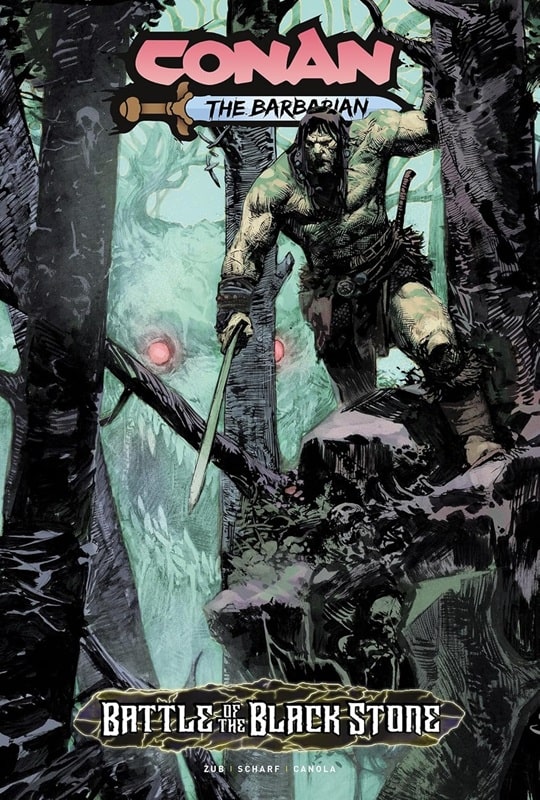 Conan the Barbarian: Battle of The Black Stone (Titan Comics collected edition, April 1, 2025). Cover by Jonas Scharf
Conan the Barbarian: Battle of The Black Stone (Titan Comics collected edition, April 1, 2025). Cover by Jonas Scharf
Few things are more ubiquitous than Conan and fantasy. Decades of sword-swinging high adventure has earned the barbarian a following most can only dream of. It’s taken the heavily thewed warrior to the big screen, Marvel Comics, and more. But it’s his latest adventure at Titan Comics that may prove to be the icing on the proverbial Shadizarian cake.
“This isn’t my first time writing Conan, but it’s definitely the most expansive opportunity I’ve ever had to chart the direction of such an amazing iconic character. I could not be happier in terms of our team and the collaboration we have in terms of story, art, and worldbuilding,” Jim Zub, writer of Conan the Barbarian at Titan Comics, shared by email.
[Click the images for Conan-sized versions.]
Over the years, few have come to understand the Cimmerian like the acclaimed Canadian scribe. Even in a career that has taken him to the heights of the comic book industry, Zub’s Conan work is special. His bibliography reads like a tour of the barbarian’s finest adventures of the past 10 years: Marvel’s Conan the Barbarian, The Savage Sword of Conan, and the epic Battle of the Black Stone are a few highlights. No wonder he’s so trusted by the rights holders of Robert E. Howard’s work.
“I actually work directly for Heroic Signatures, the rights holders of Conan and the Robert E. Howard character library. Titan publishes the comics in English, and they’ve been great publishing partners, but on a creative level I answer directly to the people who know Conan best and that has made the creative process really vibrant,” Zub stated.
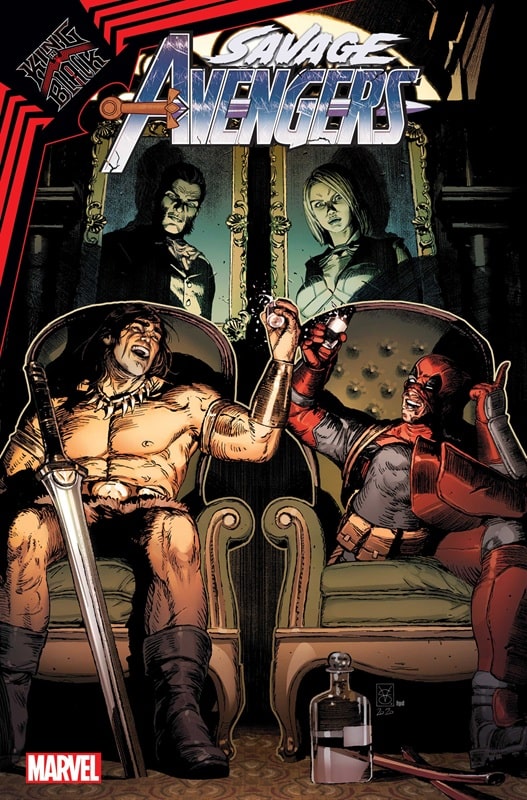 Conan and Deadpool in Savage Avengers #18, by Gerry Duggan and Kev Walker (Marvel Comics, February 17, 2021). Cover by Valerio Giangiordano
Conan and Deadpool in Savage Avengers #18, by Gerry Duggan and Kev Walker (Marvel Comics, February 17, 2021). Cover by Valerio Giangiordano
It wouldn’t be exactly fair to call Conan’s return to Titan a comeback. At Marvel, the Cimmerian had an impressive run in the much-loved Savage Avengers. Solo, he would be well-treated by Zub and his colleagues in stories like Conan: Serpent War and even fight symbiotes during the massive King in Black storyline. A look at the enthusiasm that has greeted Titan’s Conan series, however, tells you that this is something different.
Zub added, “Every time I get to contribute to characters and worlds I grew up with it’s a thrill, and this Conan publishing initiative is a whole new level.”
Such big breaks come with a heavy responsibility. After Howard created the character in the 1930s, many other writers would pen new tales for the Cimmerian. That lengthy list of scribes includes respected names like L. Sprague de Camp, Karl Edward Wagner, Roy Thomas, and Jason Aaron. How has he managed to stand out while writing a legacy character that has passed through so many legendary hands? Surprisingly, it’s by following the legends as closely as he can.
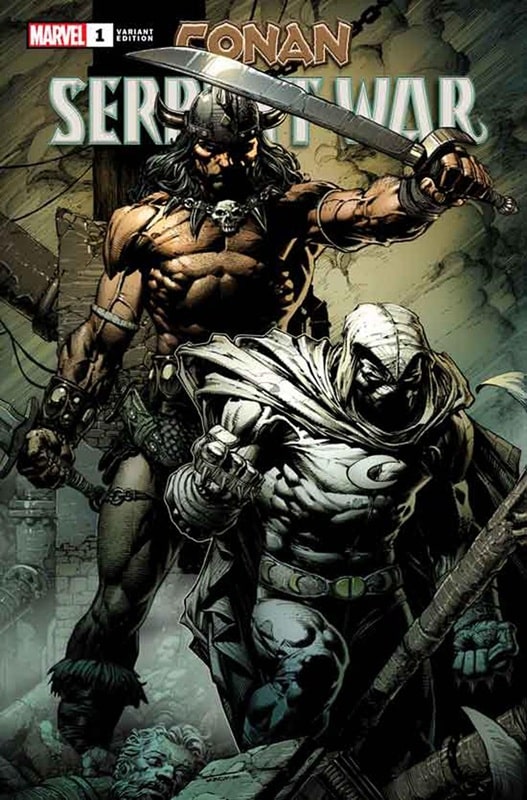 Conan: Serpent War #1, written by Jim Zub (Marvel Comics, December 4, 2019). Incentive variant cover E by David Finch
Conan: Serpent War #1, written by Jim Zub (Marvel Comics, December 4, 2019). Incentive variant cover E by David Finch
“If anything, I’m trying to hew as closely to Robert E. Howard’s original pulp characteristics as I can, while also incorporating the most iconic aspects of Roy Thomas’ seminal comic writing alongside the vision so many incredible artists like Frank Frazetta, Barry Windsor-Smith, John Buscema, Joe Jusko, Cary Nord and others have brought into it over the decades,” Zub explained.
Following in those footsteps brings with it plenty of challenges and opportunities. There aren’t many writers that understand that as well as Zub.
“The longer a character has been around, obviously, the more stories have been told and the harder it can be to surprise the existing fanbase while still staying true to who that character is. It’s a delicate balance where you want to keep core elements in mind but not close yourself off to new ideas,” Zub said. “The upside, of course, is the fact that legacy characters have that built-in recognition. I’m not building from scratch in terms of visibility and there’s an existing fanbase excited to see what comes next. The challenges and benefits are tightly wound together.”
You only need to read the massive Conan: Battle of the Black Stone limited series to see that approach in practice.
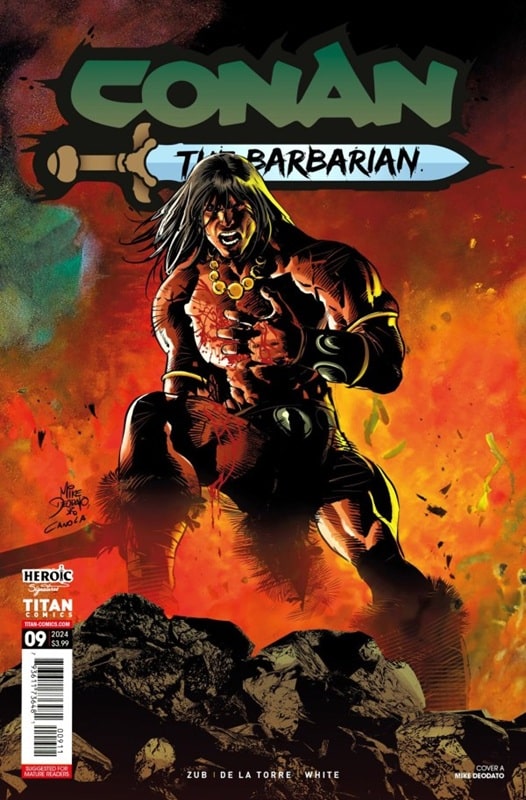 Conan the Barbarian #9, written by Jim Zub; art by Robert De La Torre and Dean White (Titan Comics, March 27, 2024)
A Walk With Titan
Conan the Barbarian #9, written by Jim Zub; art by Robert De La Torre and Dean White (Titan Comics, March 27, 2024)
A Walk With Titan
If one word could describe what it is like to read Titan Comics Conan the Barbarian, that word would be ‘fun.’ Not that it shortchanges readers on the artistic or deeper side of things. Far from it. The colors pop like a 70s comic, there’s no shortage of poetic allusions, well-crafted narrations, and action. But above all its bursting with creative energy, like a room of Conan’s most talented fans were allowed to cut loose.
“The new Titan series is a Mature Readers book, so we don’t have to hold back on violence or salacious elements where appropriate. That allows us to channel the intensity of the pulp source material even more closely,” is how Zub describes it.
Fans of high-fantasy and the barbarian’s sword-swinging antics will not be disappointed. Conan is at his most lethal in many of these stories, battling Picts and challenging sorcerers with his usual bravado. The ingredients of great sword and sorcery tales are all there: magic, romance, and plenty of mayhem.
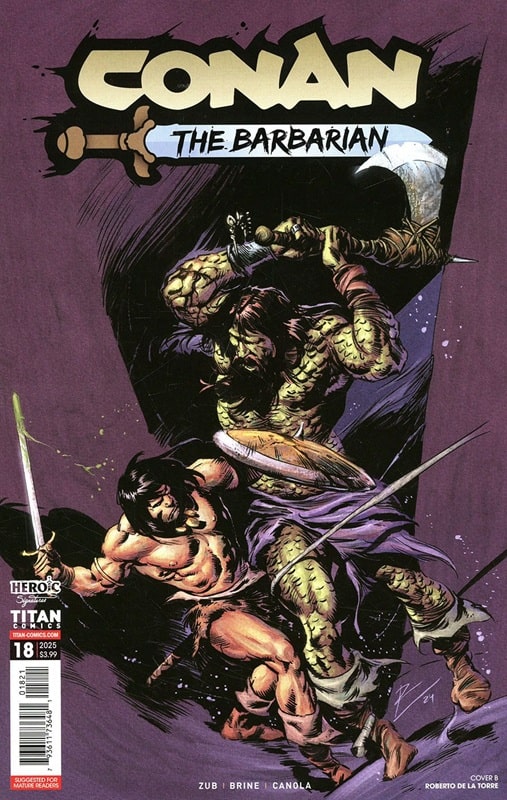 Conan the Barbarian #18, written by Jim Zub; art by Danica Brine and Joao Canola (Titan Comics, February 19, 2025). Cover B by De La Torre
Conan the Barbarian #18, written by Jim Zub; art by Danica Brine and Joao Canola (Titan Comics, February 19, 2025). Cover B by De La Torre
“It’s about distilling the best parts of past works and bringing them together with Howard’s own expansive mythmaking across the ages to tell epic stories of sword & sorcery. If I do my job well, it should feel “true” to old and new readers without falling back on adapting previous stories,” Zub said.
True to their epic vision, the creative team behind the series has not stopped at just celebrating the Hyborian Age. While the comics are full of respectful nods to the past, they also give Conan plenty of new obstacles to overcome. Other Howard characters are brought in and before you know it, a sprawling multi-timeline adventure is unfolding. Working on Conan, in general, has helped Zub level-up as a writer and his Titan Comics storylines feel like years of hard-work distilled for our reading pleasure.
“With each new storyline I’m pushing myself to use familiar pieces in unorthodox ways so that readers can see enough of the familiar to know that it’s still Conan, but knot know exactly which way the story is headed,” Zub said.
His evocative narrations have become integral to the experience. They set the tone, heighten the drama when necessary, and add some appreciated literary flair. It is no accident either that they read so quintessentially Conan.
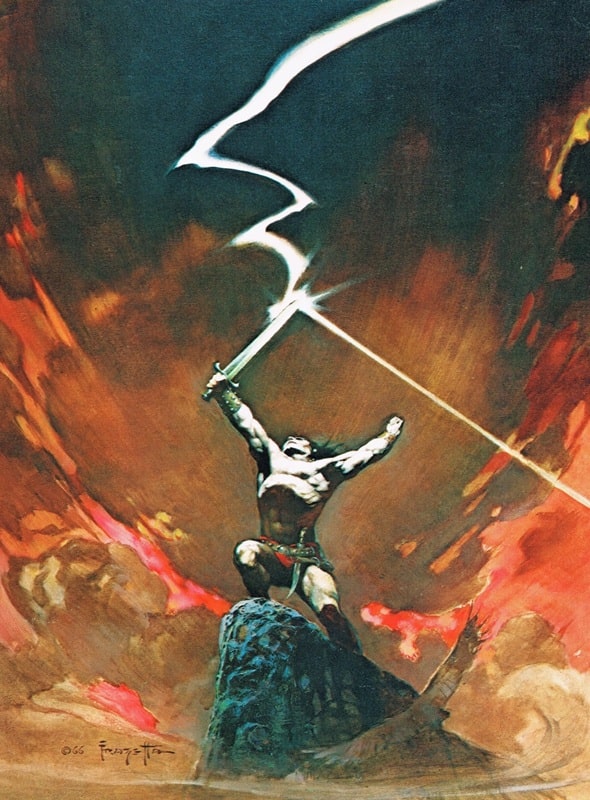 Classic barbarian art by Frank Frazetta: the cover to Thongor Against the Gods by Lin Carter (Paperback Library, November 1967)
Classic barbarian art by Frank Frazetta: the cover to Thongor Against the Gods by Lin Carter (Paperback Library, November 1967)
“I’ve marinated in the original Howard prose and analyzed it for cadence and vocabulary to make my narration feel like the classics without just copying it word-for-word. It’s made me think deeper about pacing, prose, characterization, geography, and culture,” Zub said.
The Battle for the Black Stone storyline has been a wild ride to say the least. While it’s impossible say where Conan is heading next, Zub’s work has left creatives of every level with plenty to learn from.
“There’s a reason why characters like Conan have stood the test of time and it’s crucial for people working on the property to understand and respect that bedrock foundation even while they bring their new ideas into the mix. Longtime fans can always tell if someone has done the research and cares about what they’re working on and, if you can win them over, it’s easier to build a strong audience from there,” Zub stated.
Ismail D. Soldan is an author, journalist, and poet. His work has previously appeared in Illustrated Worlds, LatineLit, and The Acentos Review among other publications. A proud explorer of both real and imagined worlds, his most recently published short story can be read in the January 2025 issue of Crimson Quill Quarterly, and his last article for Black Gate was An Eternal Champion’s Legacy.
The Leaning Pile of Books
The Leaning Pile of Books is a feature in which I highlight books I got over the last week that sound interesting—old or new, bought or received in the mail for review consideration. Since I hope you will find new books you’re interested in reading in these posts, I try to be as informative as possible. If I can find them, links to excerpts, author’s websites, and places where you can find more information on the book are included, along […]
The post The Leaning Pile of Books first appeared on Fantasy Cafe.Fan of the Cave Bear
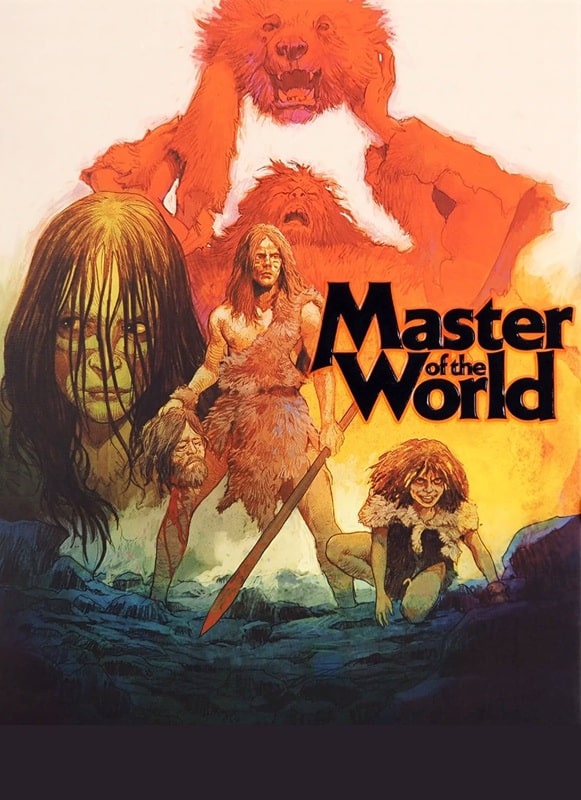 Master of the World (Falco Film, 1983)
Master of the World (Falco Film, 1983)
As usual, 20 films, all free to stream, and I’ve never seen them before. Can I really find 20 cave person films I can sit through?
EDIT: No. I’ve expanded the list to include any and all primitive cultures as there are not enough prehistoric flicks to watch.
EDIT: I’m capping this list at 10 – I can’t stomach any more f**king Italian cannibal flicks.
Master of the World (1983) TubiAgainst my better judgement, I’m starting a new list. The usual rules apply — 20 films, free to stream, based on a theme. This time, cave folk!
We kick off with this Italian offering from the early 80’s, obviously inspired by Quest for Fire and, um, possibly Caveman. It’s the old story of forbidden love, rival clans beating each other up and eating the brains of the vanquished, plus the invention of the bolas. It’s the Romeo and Juliet adaptation you never knew you needed.
The whole shebang is peppered with grainy stock footage of out-of-place animals and clouds, and there’s a man in a bear suit intercut with a real, heavily drugged bear, who beats the crap out of everyone. Actually, this semi-fake bear was a highlight.
As any nerd worth their salt will tell you, Ben Burtt used the sounds of a bear to create Chewbacca’s guttural growls. I swear to God, the filmmakers just took soundbites of Chewbacca from Star Wars and dubbed their own bear with them. Check it out — validate me!
Ultimately, a rather tedious affair, too much high-pitched grunting. I’m only one film in, and already regretting this.
3/10
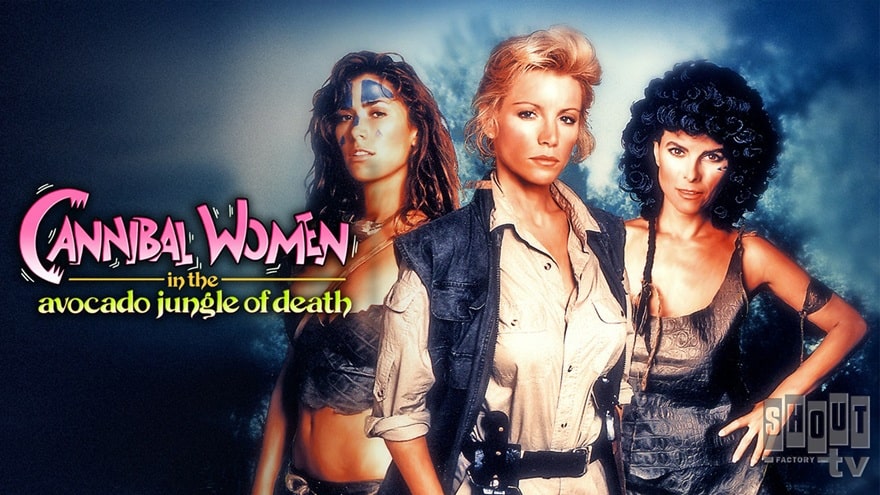 Cannibal Women in the Avocado Jungle of Death (Paramount Home Video, 1989)
Cannibal Women in the Avocado Jungle of Death (1989) Tubi
Cannibal Women in the Avocado Jungle of Death (Paramount Home Video, 1989)
Cannibal Women in the Avocado Jungle of Death (1989) Tubi
Confession: I could only find about a half dozen prehistoric cave people flicks (that I hadn’t seen or are free to stream), so I have expanded the parameters to include any ‘primitive’ cultures or groups. This opens up the doors for a wider selection, and a lot more rubbish. Case in point…
I thought I had seen this, but I was probably confusing it with Amazon Women on the Moon — anyhoo, this is a weird little affair, very cheaply made, and a bit of a mess. I’ve seen it described as a comedy horror, but there’s no horror in it, and very little in the way of good comedy. The script, written by director J.F. Lawton (who wrote Pretty Woman and Under Siege!) is really not as funny as he thinks it is, flip-flopping between absurdist schtick in the Airplane vein, to satirical monologues — all of which outstay their welcome very quickly.
Shannon Tweed is perfectly fine as the lead, but Adrienne Barbeau is wasted, and the least said about Bill Maher the better (although he does nail a couple of pratfalls). The film claims to be a commentary on feminism and toxic masculinity, but neither theme is realised due the reliance on tired tropes (the male gaze, the white male savior). Oh well.
4/10
 The Slime People (Donald J. Hansen Enterprises, 1963)
The Slime People (1963) Prime
The Slime People (Donald J. Hansen Enterprises, 1963)
The Slime People (1963) Prime
A primitive prehistoric race rises from the sewers to reclaim the planet after some misguided nuclear testing? Yes, this fits the criteria.
Is it any good though? Weeeellll…
It starts off pretty well. A lone pilot flies into a California airport, only to find the entire town deserted. It’s well set up, and would be even more effective if the film hadn’t shown us the titular monsters as soon as the film starts, before the credits. The monsters themselves are quite interesting, however it looks like they blew the budget on three full-size costumes; think Dr. Who‘s Zygons wearing gorilla pants.
The rest of the ensemble is made up of the usual suspects: lantern-jawed Clark Gable-lite, useless scientist, useless scientist’s useless daughters, useless marine (only there to say ‘gee whiz’ and kiss a useless daughter) and a nutcase who has ‘uncomfortable feelings’ for his goat. You read that right.
The whole affair is shrouded in fog (a major plot point) as mostly consists of lots of talking and running through the afore-mentioned fog. It’s a bit rubbish, but strangely compelling.
5/10
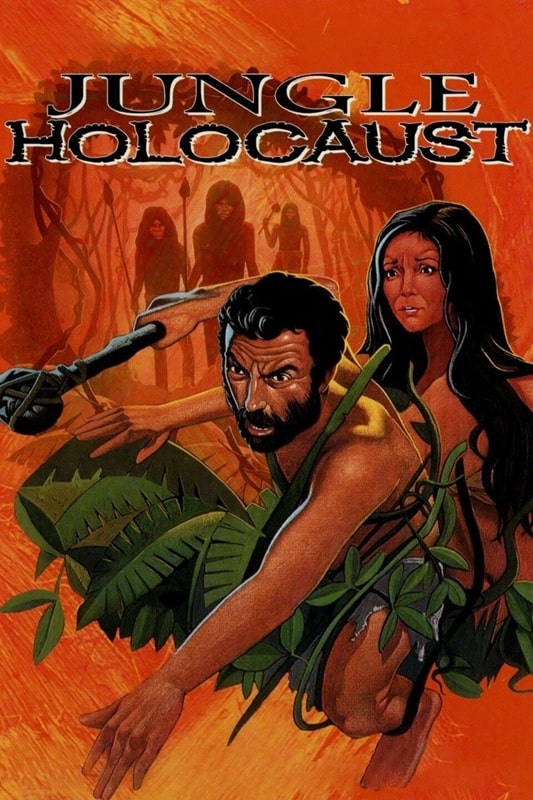 Jungle Holocaust (Erre Cinematografica, 1977)
Jungle Holocaust (1977) Tubi
Jungle Holocaust (Erre Cinematografica, 1977)
Jungle Holocaust (1977) Tubi
Of all the horror sub-genres, jungle cannibal ones are my least favourite. There’s simply no joy to be found in any of them, and combine them with the Italian predilection for animal cruelty, and you’ve got a film I never need to see twice. This one is the first foray into the genre by the much lauded Ruggero Deodato, and it’s not as ghastly as his later offerings, but still enough to leave me questioning my life choices. I can deal with the human-on-human buffets, but the suffering of real animals turns my stomach.
Anyhoo — it’s the usual plot; white Italians enter the jungle, get eaten. Along the way there is stock footage of animals eating each other, ants in wounds, copious willy tugging (some bad, some good) and lots of ‘oo, oo, oo’ ‘aah, aah, aah’.
The leads are pretty good, Massimo Foschi really sells the whole jungle madness look, and Me Me Lai is great as the loveliest cannibal of them all. However, at the end of the day I don’t mean to be judgemental, but I have no idea how anyone can watch these for a good time.
6/10
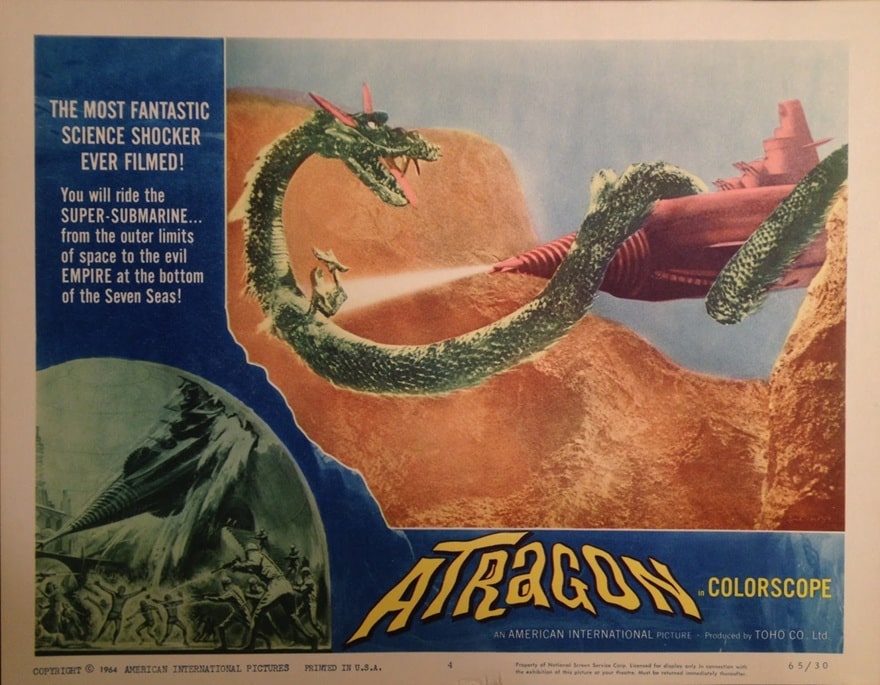 Atragon (Toho, December 22, 1963)
Atragon (1963) Prime
Atragon (Toho, December 22, 1963)
Atragon (1963) Prime
A tenuous fit for this project, Atragon features an ancient civilization (the Empire of Mu) hellbent on reclaiming their position as rulers of the world. For now, their continent lays at the bottom of the Pacific, so the film is all about Japan’s experimental submarine program, patriotism, and nefarious agents.
The entire world rallies via stock footage as the Mu Nemo themselves around the globe, sinking ships and being a general nuisance. Lots of lovely matte paintings and Thunderbirds-style models, and a bonus sea monster at the end. I had fun.
6/10
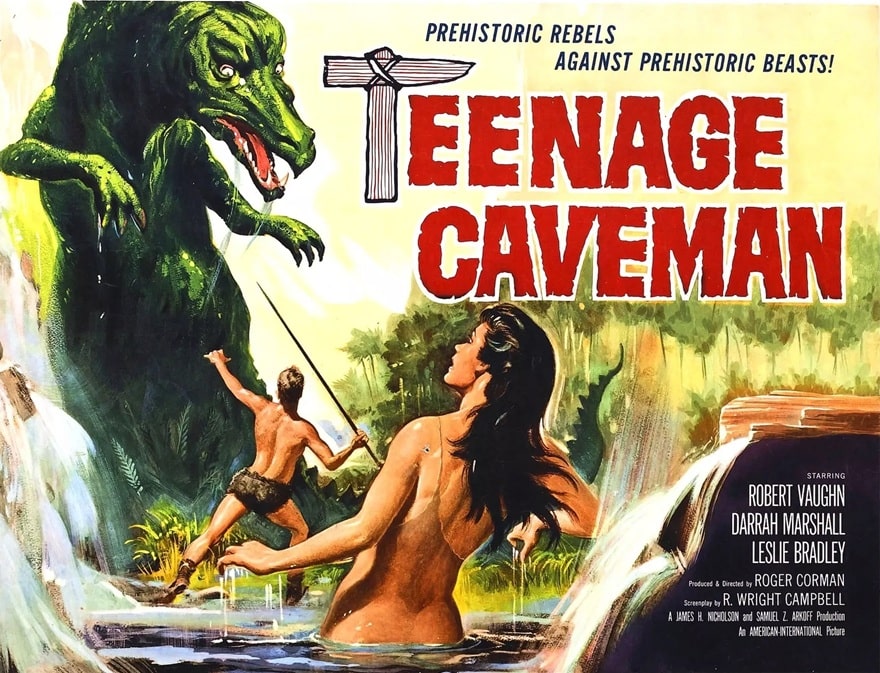 Teenage Caveman (American International Pictures, July 1, 1958)
Teenage Caveman (1958) Prime (AMC+)
Teenage Caveman (American International Pictures, July 1, 1958)
Teenage Caveman (1958) Prime (AMC+)
Yes, I started a free 30-day trial sub to AMC+ just so that I could watch this movie without the MST3K voice track. Such is my commitment to this pointless exercise in procrastination.
Anyhoo — here we have Roger Corman writing and banging out a caveman film in a couple of weeks. All shot on one California location, amply sprinkled with footage from other AIP flicks, featuring a very young Robert Vaughn as a young ‘cave person’ in the midst of an existential crisis. The clan he belongs to is the cleanest, whitest bunch of knuckle-draggers you’ve ever seen, and their hair is perfect. They all adhere to a bunch of rules attributed to Sky Gods and Monsters (TM), but Bobby Vaughn ain’t down with no rules, daddio.
He rebels, as all teens should, and while the elders sit around at camp discussing the rules, he goes out to see what’s so dangerous about the other side of the river. Here’s the thing, despite it being cheesy as hell, and somewhat laughable, Vaughn plays it straight (the right choice) and Corman clubs us around the head with a killer twist. I rather enjoyed it. Second film to feature a dude in a bear costume too, so it gains back the mark I was about to take away for the cruel real animal fighting.
6/10
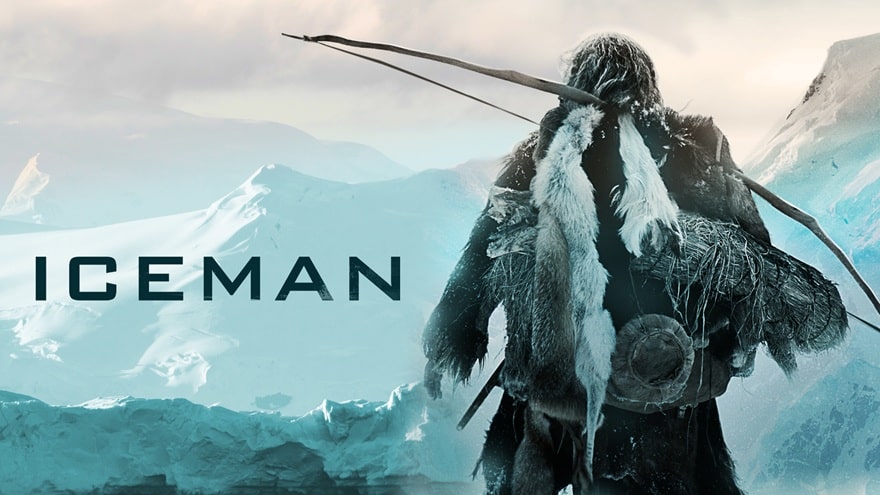 Iceman (Echo Film/Lucky Bird Pictures, 2017)
Iceman (2017) Tubi
Iceman (Echo Film/Lucky Bird Pictures, 2017)
Iceman (2017) Tubi
Based on a 5300-yr-old mummy found by hikers in 1991, this German production proceeds to tell the imagined last days of a Neanderthal man, Kaleb. It’s a simple revenge flick, told in the ancient Rhaetic language, and is beautifully shot through with a suitably grim palette.
Jürgen Vogel as Kaleb is brilliant, bringing physical and emotional heft to every scene, and it was a treat to see Franco Nero pop up. It’s solid, at times horrific, and a reminder that revenge is a dish best served hunted, skinned and roasted.
8/10
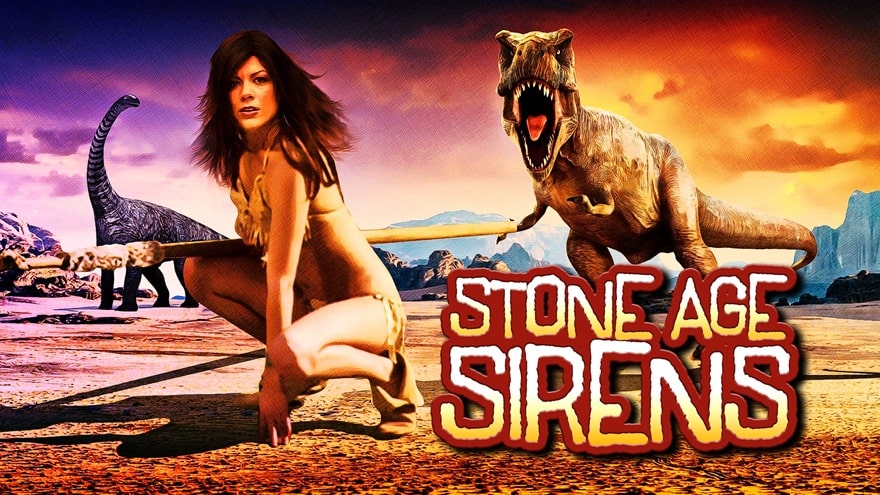 Stone Age Sirens (Retromedia Entertainment, November 16, 2004)
Stone Age Sirens (2004) Tubi
Stone Age Sirens (Retromedia Entertainment, November 16, 2004)
Stone Age Sirens (2004) Tubi
Another Fred Olen Ray flick (credited as Nicholas Medina, his soft-core pseudonym), this one is a heavily edited version of the film Teenage Cave Girl, heavily edited to the point where there’s no actual Neanderthal nookie on display at all. By cutting out all the sex scenes, what you are left with is a rubbish comedy about a pair of cave dwellers who are transported to the future and fall in with some randy archeologists (there’s more than you knew).
Peppered with stop-mo shots stolen from Planet of the Dinosaurs and some abominable CG in all its 8-bit glory, this is the usual slice of fried shite I’ve come to expect from the once great Ray. It gets a point for only being 46 minutes long.
1/10
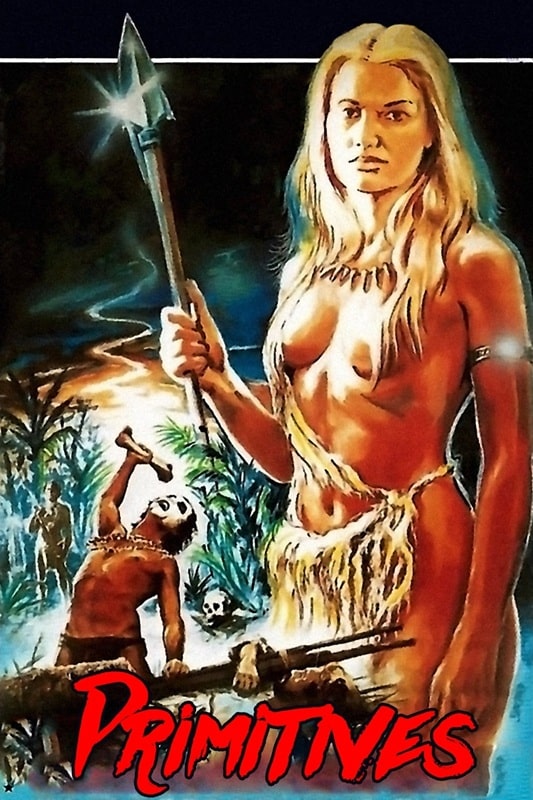
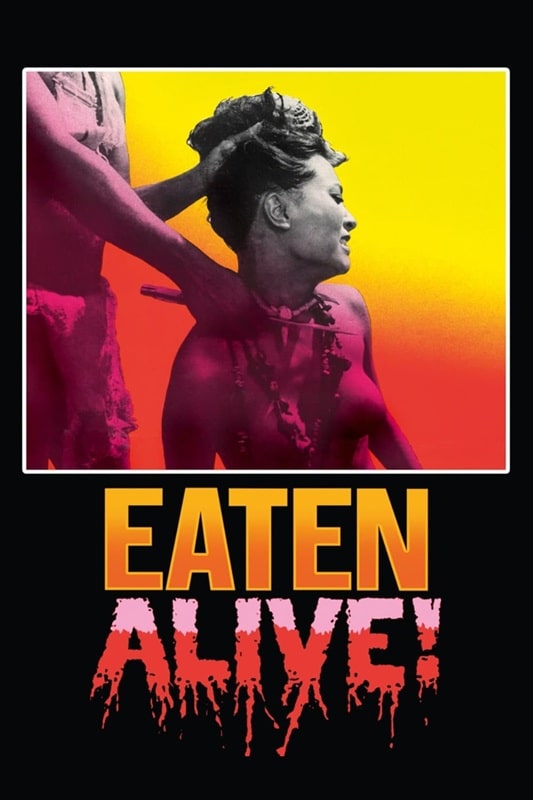
Primitives (Rapi Films, 1978) and Eaten Alive! (Dana Film, March 20, 1980)
This one is an Indonesian version of the Italian jungle exploitation flicks, and doesn’t just follow a similar plot, but lifts whole sequences directly for previous fare such as Cannibal Holocaust. In fact, it’s pretty shameless how much is ripped off from that movie, right down to locations and set pieces (although it stops short of actual tallywhacker removal). It’s full of the usual grunting and chomping, and the filmmakers seemed to double-down on the animal cruelty, using horrific footage from previous films.
It’s a miserable viewing experience, and I’m only giving it an extra mark for the shameless stealing of inappropriate music (Kraftwerk’s ‘The Robots, a trio of Jean Michel Jarre tracks and Princess Leia’s theme) and a hilarious rubber axe boomerang scene.
4/10
Eaten Alive! (1980) TubiNot to be confused with the Tobe Hooper ‘gator romp, this is another Italian cannibal flick that starts interestingly in New York, but then descends into the usual animal torture and misogyny associated with these films.
It’s held together by a flimsy ‘Jonestown’ plot, but this was the one that officially finished me off — I am totally done with this genre and never need to see another jungle cannibal film ever again. Hateful.
1/10
Previous Murkey Movie surveys from Neil Baker include:
There, Wolves
What a Croc
Prehistrionics
Jumping the Shark
Alien Overlords
Biggus Footus
I Like Big Bugs and I Cannot Lie
The Weird, Weird West
Warrior Women Watch-a-thon
Neil Baker’s last article for us was There, Wolves: Part III. Neil spends his days watching dodgy movies, most of them terrible, in the hope that you might be inspired to watch them too. He is often asked why he doesn’t watch ‘proper’ films, and he honestly doesn’t have a good answer. He is an author, illustrator, outdoor educator and owner of April Moon Books (AprilMoonBooks.com).
6 Books Begging To Be Held & The Advantages of Reading Them
In a society ruled by digital displays, it’s simple to overlook the pure pleasure and…
The post 6 Books Begging To Be Held & The Advantages of Reading Them appeared first on LitStack.
ROSE / HOUSE by Arkady Martine
Rules for Mega-Dungeon Adventuring: Dragonslayer by Greg Gillespie
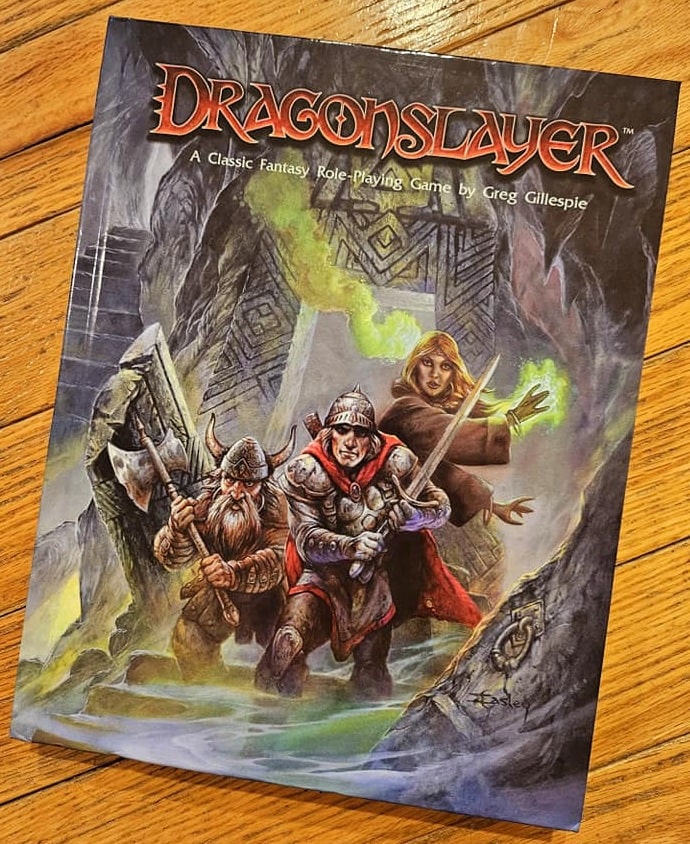
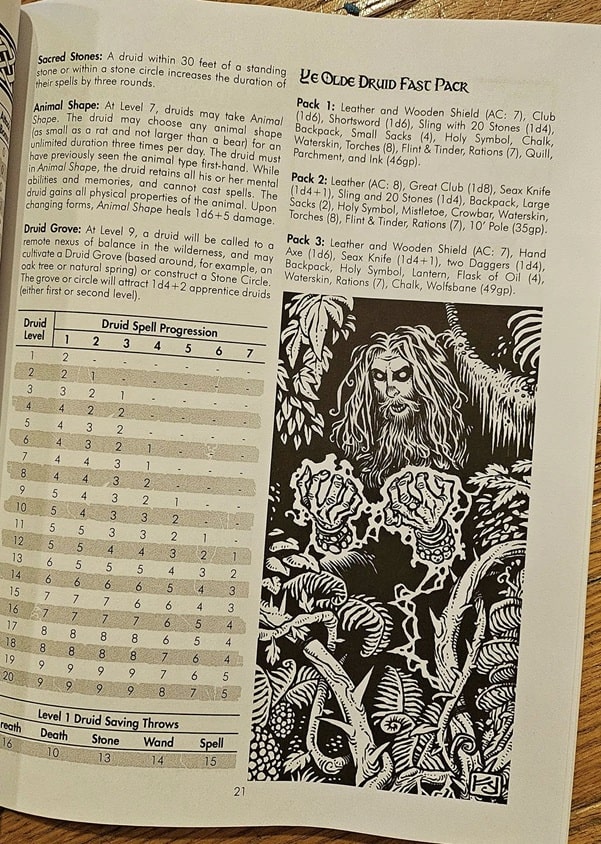
Dragonslayer (OSR Publishing, February 7, 2024). Cover by Jeff Easley
I’ve admired the mega-dungeon adventures of Greg Gillespie for several years, particularly Barrowmaze and The Forbidden Caverns of Archaia. Most recently, Greg published his own set of rules to go with those adventures. It’s called Dragonslayer, and I think it’s excellent. Here is the description from the back of the book:
Journey to a realm of myth and magic, where ancient legends and terrifying minsters come to life, and adventure awaits…
Inspired by the timeless role-playing tradition of the early 1980s, this ruleset seamlessly integrates the simplicity of B/X with the chrome if First Edition. The book has everything you need: classes, spells, monsters, and treasure, combined in a single volume.
For those who don’t know, “B/X” is the acronym for the Basic and Expert rules of Dungeons & Dragons.
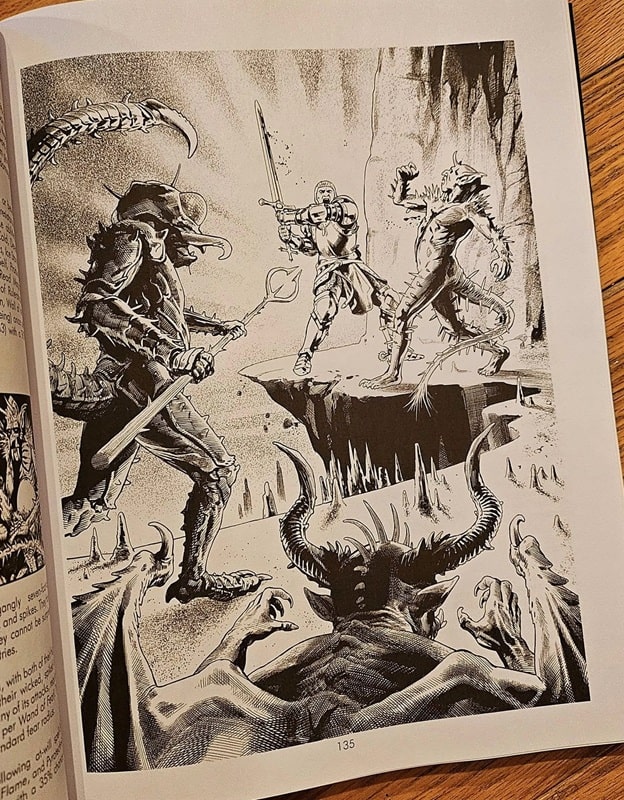
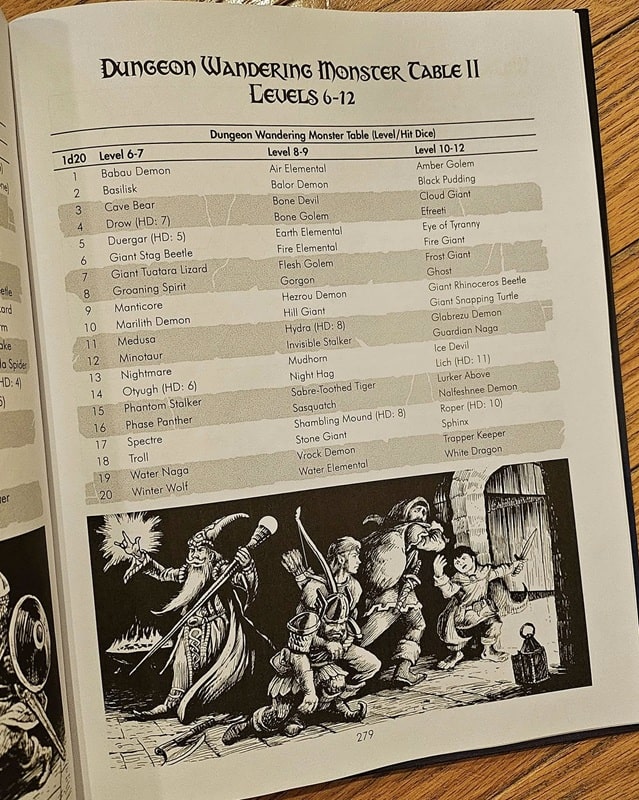
Interiors from Dragonslayer
The Basic and Expert rules were conceived by Tom Moldvay and Zeb Cook, who in turn derived their inspiration from the works of Gary Gygax and Dave Arneson — and also the previous Basic set (my personal favorite) compiled by John E. Holmes.
B/X is probably the most “cloned” version of D&D, yet Greg establishes his own flavor, quite admirably, within that framework. It’s nicely done!
Lastly, it’s really great to see art from the likes of Jeff Easley, Diesel LaForce, and Darlene Artist. All legends of the hobby whose work I have admired for decades.
Jeffrey P. Talanian’s last article for Black Gate was a review of Robert E. Howard’s “Worms of the Earth.” He is the creator and publisher of the Hyperborea sword-and-sorcery and weird science-fantasy RPG from North Wind Adventures. He was the co-author, with E. Gary Gygax, of the Castle Zagyg releases, including several Yggsburgh city supplements, Castle Zagyg: The East Mark Gazetteer, and Castle Zagyg: The Upper Works. Read Gabe Gybing’s interview with Jeffrey here, and follow his latest projects on Facebook and at www.hyperborea.tv.
What Moves the Dead - Book Review (reread/repost)

What Moves the Dead (Sworn Soldier #1)by T. Kingfisher
What is it about:From the award-winning author of The Twisted Ones comes a gripping and atmospheric retelling of Edgar Allan Poe's classic "The Fall of the House of Usher."
When Alex Easton, a retired soldier, receives word that their childhood friend Madeline Usher is dying, they race to the ancestral home of the Ushers in the remote countryside of Ruritania.
What they find there is a nightmare of fungal growths and possessed wildlife, surrounding a dark, pulsing lake. Madeline sleepwalks and speaks in strange voices at night, and her brother Roderick is consumed with a mysterious malady of the nerves.
Aided by a redoubtable British mycologist and a baffled American doctor, Alex must unravel the secret of the House of Usher before it consumes them all.
What did I think of it:I totally pre-ordered this book because it sounded cool and I couldn't resist that cover! (The end-papers have a really cool illustration as well.)
And this is indeed a really cool read!
It's a retelling of Edgar Allan Poe's "The Fall of the House of Usher." , but you can definitely read it without having read Poe's original. It's atmospheric, disturbing, and delightfully creepy.
I loved Alex, they're a great hero: down to earth, pragmatic, but also caring towards their friends. And their narration brings some humor to an otherwise creepy tale. Having read a lot of Poe's works, the plot wasn't unfamiliar, but the way Kingfisher gave it life and brought new things to it made that I was invested from the start.
A warning to those who might have read other books by Kingfisher (A Wizard’s Guide to Defensive Baking or Paladin's Grace for example): Kingfisher is a pen name used by Ursula Vernon for anything that doesn't fit the Ursula Vernon name, so this book is very different than some of the other books written under the Kingfisher name.
You bet i'll be trying to find more creepy, atmospheric beauty among the Kingfisher books though!
Why should you read it:It's a delightfully atmospheric read.
Thoughts on rereading:Yup: Still just as beautifully atmospheric as the first time. A total keeper. Now on to read the next one.
Book review: Castaways (The Castaways #1) by Craig Schaefer

Book links: Amazon, Goodreads
ABOUT THE AUTHOR:
Publisher: Length: Formats:
Dark academia by Craig Schaefer? Yes, please. Especially the kind that leans hard into the dark. Castaways delivers good story, some eldritch horror vibe, and strong coming-of-age arcs.
Amy Nettle is a classic down-on-her-luck protagonist. She’s stuck in a dead-end life with limited way out. And when things go really south, the mysterious black envelope arrives. Suddenly, she’s whisked away to Saunders Academy, a magical school on a storm-tossed island surrounded by carnivorous mermaids, towering leviathans, and an ever-present sense that something is very wrong.
And if you flunk out? You get sent back to your old life without your magic, your memories, or even the promise of escape. And no one here wants to go back.
I’m a huge fan of Schaefer simple and concise writing. And characters. Amy and her new friends are coming of age in the middle of a mystery that keeps getting bigger and more terrifying. There are hints that this school - and whatever forces control it - are tied to the broader Daniel Faust/Harmony Black universe, and that may suggest an even larger conflict on the horizon.
For fans of Schaefer - it’s not as dark as other series, but it does get dark here and there.
Magic school has never felt this dangerous, and I loved every second of it. Now, where’s the sequel?
We No Longer Need Aliens to Feel Alienated: State of Paradise by Laura Van Den Berg
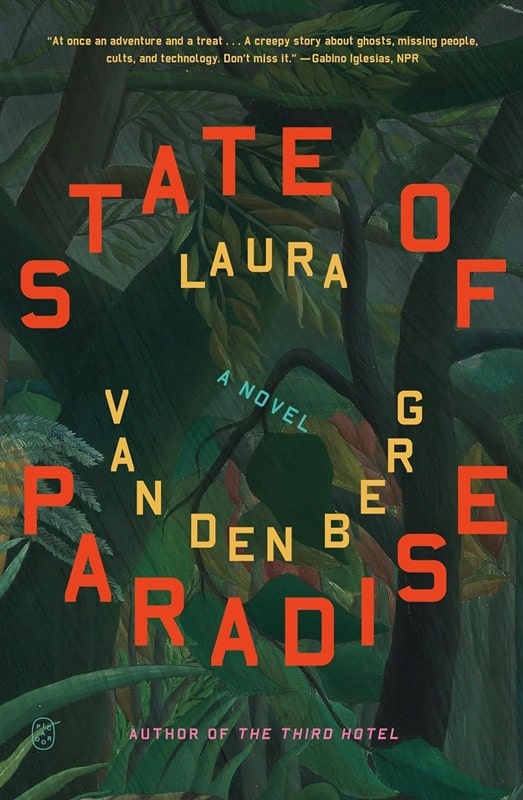
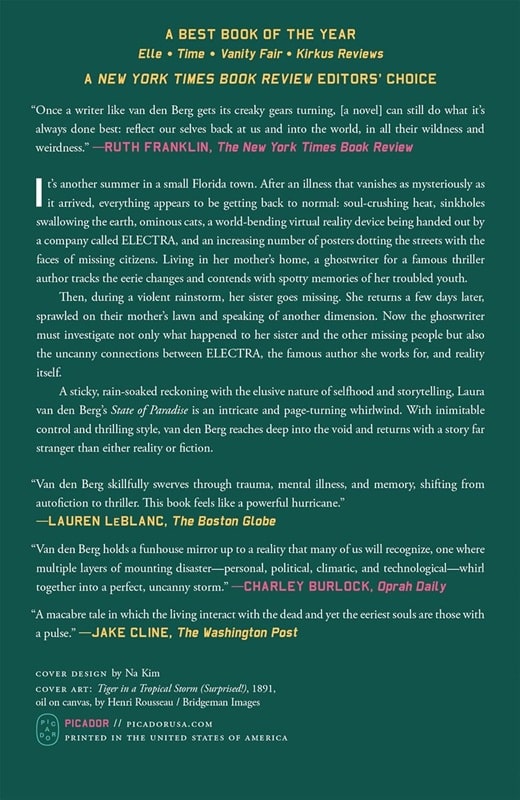
State of Paradise (Picador paperback reprint, July 8, 2025). Cover art:
detail from Tiger in a Tropical Storm by Henri Rousseau, 1891
When I was a kid there was a public service announcement on TV that went something like “Attention: Aliens. You are required by law to report by January 31st.” This was because of the Alien Act of 1940, otherwise known as the Smith Act. Basically, the legislation made it illegal to advocate the violent overthrow of the U.S. government and provided for a tracking system of non-citizens who, in the context of Nazi occupation of Eastern Europe and its then alliance with the Soviet Union, were potential suspects of espionage and sabotage. (Fun fact: prosecutions for advocating overthrow of the government have been ruled as unconstitutional violations of the First Amendment, in case you were wondering how any nitwit on social media can mouth off about doing just that.)
But as I didn’t know anything about this, the announcement always conjured an image of big headed, bug-eyed tentacled Martians registering at the local post office. Which I thought pretty funny. One thing I’ve learned over the years, and particularly these days, is that much of what adults say in all seriousness is often funny, but not in a “ha ha” way. More in a Jean Paul Sartre absurdist kind of way.
Needless to say, alien life forms are foundational science fiction, horror, and fantasy tropes. While some genre writers and filmmakers may very well have thought it just might be cool to tell stories about monsters from other worlds, the notion of aliens amongst us primarily serve as metaphors for, among other things, Communists and related usurpers of “normal” socio-political mores, fears of nuclear holocaust, technology run amok, repressed sexual desire, climate change, disease, and disembodiment.
Probably to a large extent due to the COVID-19 pandemic as well as severe climate events such as the California wildfires, today’s alienation storyline is less “aliens amongst us” and more “us alienated from the world.”
Which brings us to State of Paradise by Laura Van Den Berg.
The title is ironic, referring not only to Florida and its reputation as a refuge for the aged retired, the sunburned, and the weird, but that if the existential human condition is sometimes characterized using the Biblical metaphor of banishment from Eden, we currently find ourselves further away from Paradise than ever before.
In Florida, my husband runs. Ten miles a day seventy miles a week. a physical feat that is astonishing to me. He started running after he got stuck on a book he is trying to write, a historical account of pilgrims in medieval Europe. Back then it was not unusual for pilgrims to traverse hundreds of miles on foot… My husband is a trained historian and fascinated by journeys. He wants to understand what has become the pilgrimages in our broken modern world.
The first person narrator is
…a writer, though not a real one, I ghost for a very famous thriller writer. When I first got the job, I spent a month reading books by the famous author, to better understand the task that lay before me… the phrase everything is not as it seems appeared in nearly all the book descriptions.
Indeed, everything is not as it seems as the narrator (a kind of ghost herself) proceeds on a pilgrimage not only through actually weird Florida, where the 1930s Tarzan movies were filmed and non-native Pythons abound alongside Everglades alligators and Disney characters, but an alternate reality to which her sister and others somehow travel. Along the way are treated to torrential rain and flooding, sinkholes, virtual reality headsets, cults, and cats. And voluntary human extinction meetings. Just another day in Paradise.
With a history of being institutionalized, our narrator may be unreliable, and as a writer she is in the business of making things up. Not much cause for cognitive dissonance given the made-up unreliable narratives of our daily news cycle.
The plot, such that it is, concerns finding out what happened to her sister and others during their disappearances. And along the way what is happening to the narrator as she tries to figure out an increasingly strange world that nonetheless comes to define everyday existence. And whether she can trust what she is experiencing and what she remembers of those experiences.
Sometimes I wonder what we are supposed to do with our memories. Sometimes i wonder what our memories are for. A latch slips and the past floods in, knocking us flat. We leave places and we don’t leave places. Sometimes I imagine different versions of myself in all the different places I have ever lived, inching time in parallel.
This is a novel about the proverbial frog in boiling water, how because as the temperature only gradually rises, we don’t realize we’re being cooked. One absurdity follows another, and it is just how things are. We are now the aliens, journeying towards some unsettling destination, and we don’t have to bother to report.
One of the weirdest things about this period of time is the parts that still seem normal. Mundane and non-apocalyptical. Like how one minute we need an inflatable raft to cross the street and another we’re eating pasta at my sister’s house.
Or as Alice Cooper put it, “Welcome to my nightmare.”
David Soyka is one of the founding bloggers at Black Gate. He’s written over 200 articles for us since 2008. His most recent was a review of Polostan by Neal Stephenson.
Spotlight on “The Mysterious Bakery on Rue de Paris” by Evie Woods
Nestled among the cobblestone streets of Compiègne, there existed a bakery unlike any other. The…
The post Spotlight on “The Mysterious Bakery on Rue de Paris” by Evie Woods appeared first on LitStack.
On McPig's Radar - They Bloom at Night
 They Bloom at Nightby Trang Thanh Tran
They Bloom at Nightby Trang Thanh TranA red algae bloom has taken over Mercy, Louisiana. Ever since a devastating hurricane, mutated wildlife lurks in the water that rises by the day. But Mercy has always been a place where monsters walk in plain sight. Especially at its heart: The Cove, where Noon’s life was upended long before the storm at a party her older boyfriend insisted on.
Now, Noon is stuck navigating the submerged town with her mom, who believes their dead family has reincarnated as sea creatures. Alone with the pain of what happened that night at the cove, Noon buries the truth: she is not the right shape.
When Mercy’s predatory leader demands Noon and her mom capture the creature drowning residents, she reluctantly finds an ally in his deadly hunter of a daughter and friends old and new. As the next storm approaches, Noon must confront the past and decide if it’s time to answer the monster itching at her skin.
Of Men, Monsters, and Little People
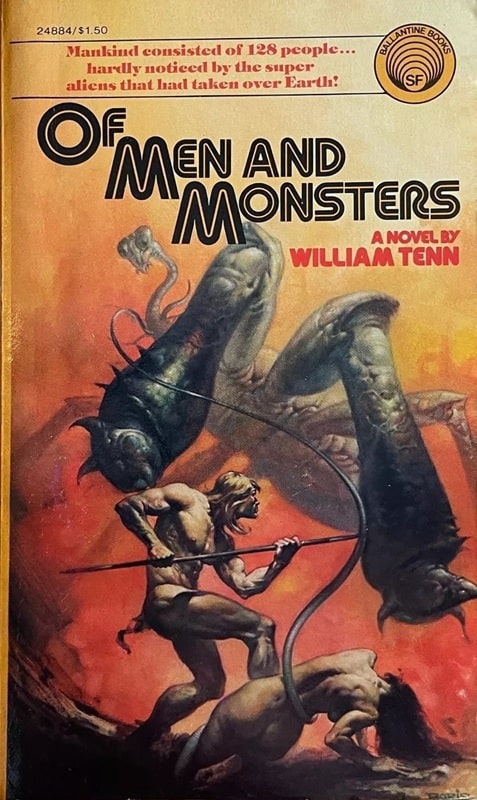
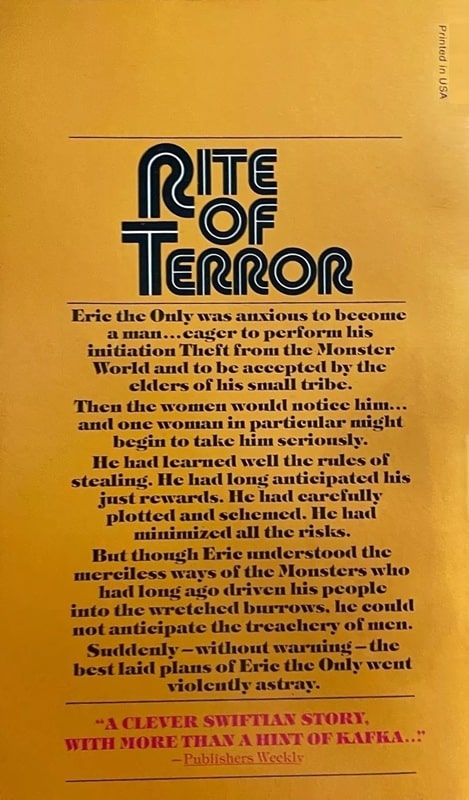
Of Men and Monsters, by William Tenn
(Ballantine Books, December 1975). Cover by Boris Vallejo
After posting about The Borrowers by British author Mary Norton (1903 -1992) last week, several people mentioned other books and movies with similar kinds of themes — little people living in the houses of big people. I thought I might take another post to discuss a few other examples from my own book collection.
First up is series by American author John Peterson (1924 – 2002). The first one was just called The Littles and was published in 1967, 15 years after The Borrowers (1952). The Littles live much like the “borrowers. They look human except for having tails. (In films they apparently look very mouselike but that’s not the case in the books.)
[Click the images for less little versions.]
 The Littles, by John Peterson (Scholastic Books, 1991-1993 editions). Covers by Jacqueline Rogers.
The Littles, by John Peterson (Scholastic Books, 1991-1993 editions). Covers by Jacqueline Rogers.
Unlike with The Borrowers, I never heard of The Littles until I was buying books for my own son, (Josh), even though many were written when I was a kid. I stopped by Josh’s school to pick him up one day and they were having the Scholastic Book fair.
When I was a kid, we never had a fair where you could actually see the books, but we did get the order forms and I bought quite a few books through them for 25 cents or so when in grade school. I had to stop by this one at my son’s school and found out about The Littles. I bought every one they had, ostensibly for my son but at least halfway for myself. I read them all, too, although I don’t think Josh read them all.
There are a bunch of these books and more were written after Peterson’s death, but here are the ones I have. All covers are by Jacqueline Rogers, with charming interior illustrations by Roberta Carter Clark. (These are written specifically for children and I don’t think the stories are as good as in The Borrowers series, but they are fun.)
The Littles, 1967
The Littles have a Wedding, 1971
The Littles and the Trash Tinies, 1977
The Littles Go Exploring, 1978
The Littles and the Lost Children, 1991
The Littles and the Terrible Tiny Kid, 1993
In my twenties I came upon another series about tiny people. This was a trilogy by Gordon Williams (1934 – 2017) that included The Micronauts (1977), The Microcolony (1979), and Revolt of the Micronauts (1981) — all from Bantam Books.
 The Micronauts by Gordon Williams (Bantam Books, August 1977, May 1979, and August 1981). Covers by Boris Vallejo, Lou Feck, and Peter Goodfellow
The Micronauts by Gordon Williams (Bantam Books, August 1977, May 1979, and August 1981). Covers by Boris Vallejo, Lou Feck, and Peter Goodfellow
These are SF novels, not to be confused with the toy series and comic book series from Marvel with the same name — which I’d never heard of until I started looking into stuff for this post. The difference here is normal sized people are cloned at 1/8th their natural size in order to deal with a catastrophic future where most natural resources have been exhausted. The experiment is set up in a controlled environment but things soon get out of control.
I liked all three very much and they had some cool covers. The Micronauts has a Boris Vallejo cover and interior illustrations. The Microcolony has a wonderful Lou Feck cover that I love. Revolt has a Peter Goodfellow cover.
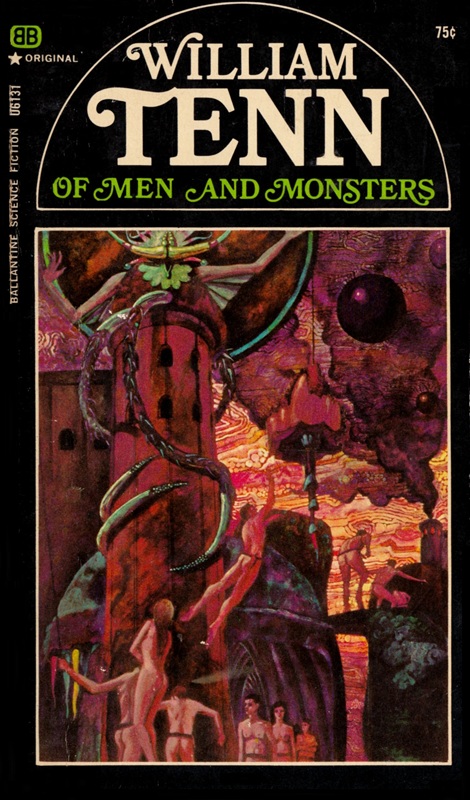
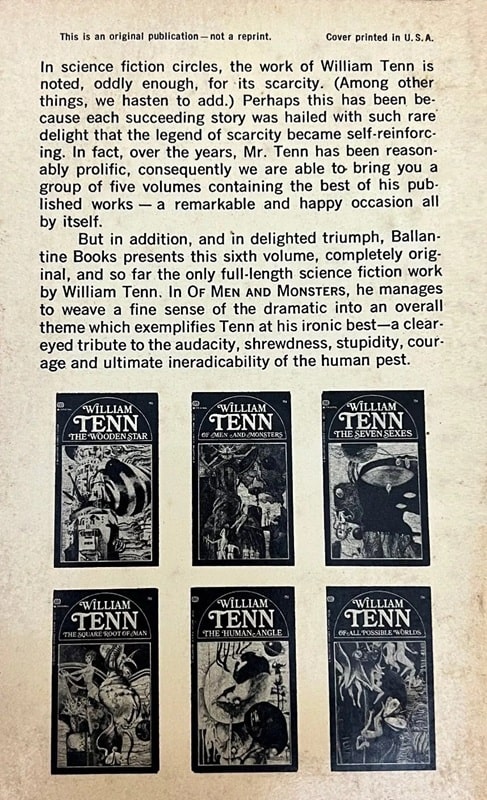
Of Men and Monsters, by William Tenn
(Ballantine Books, June 1968). Cover by Stephen Miller
The last book I’ll review today is one of the first adult SF novels I ever read, Of Men and Monsters, by William Tenn (1920 – 2010). It’s still a fond memory. Tenn was the pseudonym for a British born author named Phillip Klass, although he moved to the US before he was 2. The book was published in 1968 and I read it in a library edition, but years later I bought a Del Rey printing with a great cover by Boris Vallejo (see top).
This one has its own twist on the theme. The people are normal sized, but they are survivors of an invasion by gigantic aliens so huge that the humans can live like mice in their walls. I just loved it, and found out from Adam Tuchman on Facebook that it was originally published in a shorter version in the October 1963 issue of Galaxy, called “The Men in the Walls.”
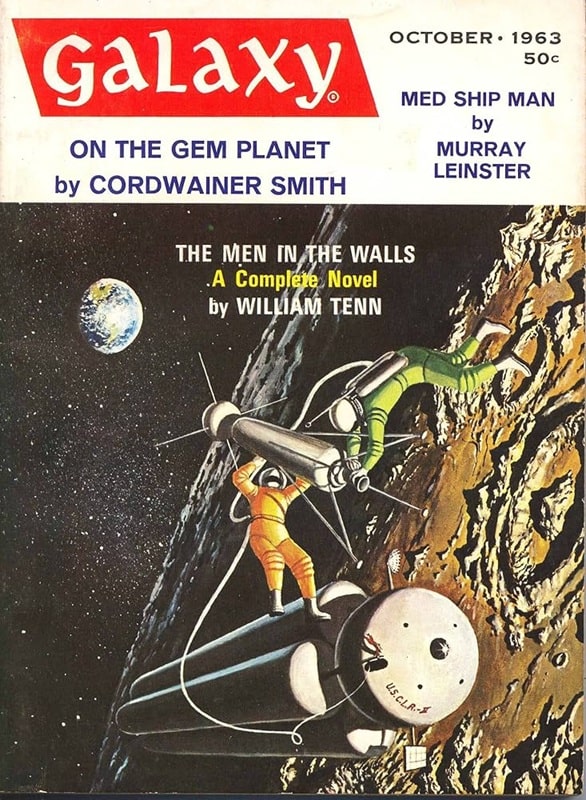
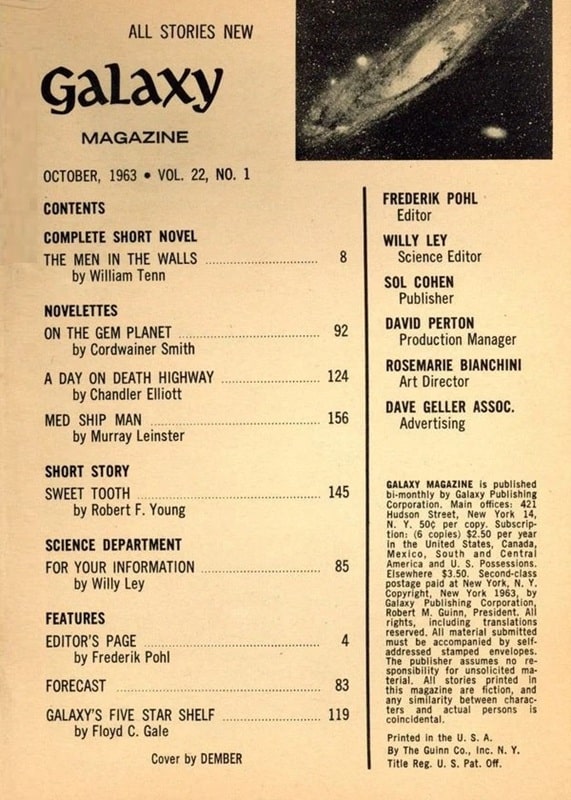
Galaxy, October 1963, containing “The Men in the Walls,” plus stories
by Cordwainer Smith, Murray Leinster, and more. Cover by McKenna
I’ll note that the ending Of Men and Monsters takes us into Sword & Planet territory.
There are plenty more I could talk about here, such as Lindsay Gutteridge’s Cold War in a Country Garden Trilogy, and Ben Sheppard reminded me of an awesome story called “Surface Tension” by James Blish, which deals with the miniaturization theme. There’s Asimov’s Fantastic Voyage, and even the movie Honey, I Shrunk the Kids, but this post is getting long as it is.
Charles Gramlich administers The Swords & Planet League group on Facebook, where this post first appeared. His last article for Black Gate was And Now For Something Completely Different: The Borrowers, by Mary Norton.
7 Author Shoutouts | Authors We Love To Recommend
Here are 7 Author Shoutouts for this week. Find your favorite author or discover an…
The post 7 Author Shoutouts | Authors We Love To Recommend appeared first on LitStack.
The Naturalist Society - Book Review
 The Naturalist Society (The Naturalist Society #1)by Carrie Vaughn
The Naturalist Society (The Naturalist Society #1)by Carrie VaughnWhat is it about:In this magical tale of self-discovery from New York Times bestselling author Carrie Vaughn, a young widow taps into the power that will change the world—if the man’s world she lives in doesn’t destroy her and her newfound friends first.
In the summer of 1880, the death of Beth Stanley’s husband puts her life’s work in jeopardy. The magic of Arcane Taxonomy dictates that every natural thing in the world, from weather to animals, can be labeled, and doing so grants the practitioner some of that subject’s unique power. But only men are permitted to train in this philosophy. Losing her husband means that Beth loses the name they put on her work—and any influence she might have wielded.
Brandon West and Anton Torrance are campaigning for their expedition to the South Pole, a mission that some believe could make a taxonomist all-powerful by tapping into the earth’s magnetic forces. Their late friend Harry Stanley’s knowledge and connections would have been instrumental, but when they attempt to take custody of his work, they find that it was never his at all.
Tied together by this secret and its implications, Beth, Bran, and Anton must find a way for Beth to use her talent for the good of the world, before she’s discovered by those who would lay claim to her rare potential—and her very freedom.
What did I think of it:I got this book as a present from Jeffe, and it's a signed copy as well!I have read books by Vaughn before - Kitty Norville, Martians Abroad - and I really enjoyed those. But I can't say Vaughn was on my watch list. I can tell you that this book changed that!
In this alternate history there's a sort of magic - taxonomy - where if you name something, and know it, you can use the magic/power of that thing or animal. I loved learning more of this magic and how the characters used it in different ways.
As for the characters: I loved Beth from the start. She's smart, knows more about birds than a lot of experts, and managed to teach herself taxonomy, but because she is a woman she is barred from the spaces where she could do something with her knowledge. She managed to get some of her work out there under her husband's name, who (all other stuff he did aside) at least encouraged her work. But when he dies, Beth is back at square one.
Enter Bran and Anton, who were friends with Beth's husband and want to use his work for their own goals.
I really loved Anton as well. He's pragmatic, charismatic, and keeps going to get things done. Bran... still needed to grow up a bit, despite being old enough he should have already. Still I liked him well enough.
I was totally invested in Beth freeing herself from the chains forged by society and find her way. When she befriends Bran and Anton, I rooted for the three of them to realize their dreams. Bran and Anton have a rival, who soon becomes a danger to Beth as well, making me anxious to see them get out of everything alive and successful.
I can safely say I loved everything about this book, even when it made me cry. I can't believe I hadn't seen it mentioned before and only discovered it when I got it as a present. Is it for everyone? I can see how people think it's too dry, there's lots of talk about the science of taxonomy, and there's bits about famous taxonomists at the end of most chapters, but I loved these parts of the book as well (yup: Nerdy Factoids McPig, and proud to be).
You bet I'll be on the lookout for the next book in this world.
Why should you read it:It's a wonderful Alternate History Read.
Book Review: The Buffalo Hunter Hunter by Stephen Graham Jones
I received a review copy from the publisher. This does not affect the contents of my review and all opinions are my own.
 The Buffalo Hunter Hunter by Stephen Graham Jones
The Buffalo Hunter Hunter by Stephen Graham Jones
Mogsy’s Rating: 4.5 of 5 stars
Genre: Horror
Series: Stand Alone
Publisher: Saga Press (March 18, 2025)
Length: 448 pages
Author Information: Website
At its heart, The Buffalo Hunter Hunter may be a vampire novel, but it’s about so much more that calling it such would be doing it a great disservice. Yes, the story involves undead, blood-drinking creatures. However, it is also a meditation on the scars of history, and, like any good western, features a tale of vengeance. In short, Stephen Graham Jones has created something far more complex than your typical vampire horror here.
The novel opens in 2012 with an introduction to Etsy Beaucarne, a junior professor at the University of Wyoming who is desperately looking for a way to revitalize her career. Her opportunity arrives when she comes into possession of a long-lost journal belonging to her great-great-grandfather, a Lutheran priest who lived in the American West in the early 1900s. Within its pages, Arthur Beaucarne had transcribed a stunning confession from a Blackfeet man named Good Stab who claimed to be an immortal vampire.
Through Good Stab’s recorded testimony, readers are plunged even farther back in time to the brutal winter of 1870, when US Army soldiers carried out the Marias Massacre that left hundreds of his people dead. Good Stab, one of the few survivors, swore that he would get his revenge, spending the next few decades hunting down those responsible. Yet his survival came at a heavy price. After losing his family, his home, and even his place in the world, Good Stab’s path changes his life forever. Possessed of both immense power and an insatiable hunger, he knows what happened to him is a curse—but it’s also one he can wield as a weapon against those who destroyed everything he once knew.
From the start, The Buffalo Hunter Hunter’s frame structure brings to mind Dracula, which is not the only nod to the classic. Stephen Graham Jones continues his homage with the epistolary style format, enhancing the story’s eerie, almost folktales-y like atmosphere. Despite its supernatural elements though, some of the most disturbing aspects of the novel are the parts rooted in reality—particularly the history of Indigenous genocide and the annihilation of the buffalo.
In Good Stab’s account, he wasn’t merely seeking revenge for the slaughter of his people, but also for the destruction of his whole way of life. His vampirism not only holds him forever in a state of constant hunger but also traps him in an endless cycle of rage and grief. Immortality offers him no peace but instead forces him to witness more loss as the years stretch on. This makes Good Stab one of the most interesting and tragic characters I’ve ever encountered. He isn’t a hero or a villain—just a man and then a creature driven by circumstance.
Like most vampire stories, The Buffalo Hunter Hunter is unsurprisingly violent and gory. That said, its horror manifests itself in lowkey, slow-burn ways as well. The author’s prose captures the harshness of the frontier, an unforgiving landscape where you are constantly struggling to survive. Though the pacing may be demanding at times, this story simply must be experienced on its own terms, requiring your full attention. With its mix of so many elements from history, mythology, and horror, this is not a book to be rushed but to be absorbed slowly, allowing its haunting themes to fully take hold.
If I had any criticisms at all, it would be that some parts of the story become repetitive at times, especially with regards to the interactions between Arthur and Good Stab. While this back and forth served to reinforce the narrative style, I think the novel could have packed the same emotion punch without being quite so long, and some streamlining would have been beneficial.
In the end, I absolutely loved The Buffalo Hunter Hunter, as in, it just might be my favorite book by the author yet. While it’s not the easiest read, the end results are satisfying and rewarding. Stephen Graham Jones’ storytelling skills are on full display here, and it would make me very happy to see him tackle more historical horror like this sin the future. Granted, I haven’t enjoyed everything he’s written, but when he’s good, he very good. And with this novel, he’s proven once again why he is one of the most important voices in the genre today. If you enjoy horror with depth, especially one exploring a dark chapter of American history, this is a must read.
![]()
![]()
SPFBO Finalist Review: The Tenacious Tale of Tanna the Tendersword by Dewey Conway & Bill Adams

ABOUT THE AUTHORS:
Bill: When not writing, Bill is a product manager for a company that tests food using analytical chemistry and microbiology. Bill currently lives in the greater Chicago, IL area with his wife, goblin (aka toddler) son, & daughter.
Dewey: When Dewey isn’t heads down into drawing or writing, he works as an instructional designer for a major learning management systems company developing online courses. Dewey lives north of Houston, TX with his wife and two dogs while his adult children are off on their own.
Find them online: The Willow Wraiths
The Tenacious Tale of Tanna the Tendersword links: Amazon, Goodreads
ESMAYSometimes you just want to turn off your brain and escape into a wild adventure, and that is exactly when books like The Tenacious Tale of Tanna the Tendersword can come to the rescue. It’s a tongue-in-cheek middle grade fantasy full of action, whimsy and humour that will undoubtedly speak to the hearts of many fantasy lovers, even if it didn’t totally manage to capture mine.
Now, when you have a story with the premise of a 13-year-old grumpy chronicler in training and a hyperactive 12-year-old would-be-champion setting out on a quest guided by a peg-legged, sword-wielding rooster to help save a crying mushroom from an evil sorceress in a haunted forest, you know it’s gonna be a wild ride. And honestly, The Tenacious Tale of Tanna the Tendersword is everything it promises to be, and I found myself effortlessly breezing through the pages.
Despite what the cover and title might make you believe, Tanna is actually not the main protagonist/narrator of this heroic tale (thank all that is holy, girlie and I did not get along), and instead we see it all unfold through the eyes of the grumpy Galdifort. For me, this worked extremely well, especially because I deeply related to his utter exasperation with Tanna’s annoyingly loud, excitable, and slightly brash personality. To me, he almost read a bit neurospicy (though that is never confirmed in the text), and I found it highly amusing to see him desperately trying to stick to the rules while Tanna just ran into chaos every opportunity she got.
That said, I personally felt like there was a lot of missed potential for more nuance, depth, and emotional complexity for these characters, and I soon found myself having a hard time staying engaged in their adventures because I just didn’t care for them. Especially for a story that challenges these young characters in so many unexpected ways, I found the lack of character development to be a bit disappointing.
Don’t get me wrong, not every story needs to be a deep character study or deliver deep philosophical messages, but I think other middle grade stories I have read (like Amari and the Nightbrothers or Nevermoor) just set the bar way higher for me in terms of impact and nuance. Moreover, I felt like this book sometimes had a bit of an identity crisis, with extremely youthful storytelling (I can’t see another CRASH!, BOOM! or ‘fopdoodle’) being mixed with long, convoluted sentences and hectic, violent action sequences that felt confusing regardless of the age of the intended target audience.
Maybe I just wanted this story to be something it was never meant to be, and I have a feeling my little quibbles won’t really bother most other readers. Plus, I think it really shows that the authors had a blast writing this story, and I can’t sit here and pretend that the irresistible chaotic charm of The Tenacious Tale of Tanna the Tendersword didn’t get to me in the end. I absolutely loved the illustrations, the mystery surrounding the disappearance of Galdifort’s aunt and her legendary champion had me eagerly turning the pages, the tongue-in-cheek way that the authors poke fun at the silly conventions of the fantasy genre had me cackling quite a few times, and honestly… how can you not love a peg-legged rooster wielding swords and spitting fire?; Peggs is the true MVP!
And although this adventure wraps up in a satisfying (if slightly rushed) way, the enticing epilogue promises much more danger, mayhem and fun to come for our dynamic duo of unlikely heroes. While I personally didn’t end up loving this story as much as I desperately wanted to, I have a feeling that The Chronicles of Tanna the Champion by Galdifort Quillpen will make fans come back time and time again for more exciting, heartwarming, feel-good adventures to get lost in.
LUKASZ
The Tenacious Tale of Tanna the Tendersword tries to be a quirky, offbeat fantasy romp with an eager heroine, a reluctant sidekick, and a peg-legged rooster who may or may not be hiding a blade. It’s got humor, it’s got adventure, and it’s got an ominous creeping fog. On paper, this sounds like a fun, middle-grade fantasy. In execution? I found it a bit underwhelming.
The biggest issue is that the book doesn’t quite commit to anything fully. The humor is present but not sharp enough to be truly funny. The adventure is in motion but rarely feels urgent or exciting. The magic system has some interesting ideas - time-based gods, song magic - but the story barely scratches the surface. Even the villains, including the ominous Thistle Willow and her foggy menace, feel more like background threats than real forces of tension. Galdifort’s grumpy Chronicler POV is a nice twist, but it doesn’t do enough (deeply subjective) to elevate the story beyond standard fare.
Younger readers new to fantasy might enjoy the lighthearted tone. Since I'm usually looking for something with more depth or originality, this one didn’t leave much of a lasting impression.
OFFICIAL SPFBO RATING

Learning to Live and Love | “Because We Must” a Memoir
Because We Must by Tracy Youngblom is a candid exploration of motherhood and grief Please…
The post Learning to Live and Love | “Because We Must” a Memoir appeared first on LitStack.
Teaser Tuesdays - What Feasts at Night
 Autumn was nearly spent, which means that many of the trees had lost their leaves. you might think that would mean that the woods had opened up, but if you think that, you have likely never been to Gallacia.
Autumn was nearly spent, which means that many of the trees had lost their leaves. you might think that would mean that the woods had opened up, but if you think that, you have likely never been to Gallacia.(page 1, What Feasts at Night by T. Kingfisher)
---------
Teaser Tuesdays is a weekly bookish meme, previously hosted by MizB of Should Be Reading. Anyone can play along! Just do the following: - Grab your current read - Open to a random page - Share two (2) “teaser” sentences from somewhere on that page BE CAREFUL NOT TO INCLUDE SPOILERS! (make sure that what you share doesn’t give too much away! You don’t want to ruin the book for others!) - Share the title & author, too, so that other TT participants can add the book to their TBR Lists if they like your teasers!
SPFBO Finalists Interview - Dewey Conway & Bill Adams, Co-Authors of The Tenacious Tale of Tanna the Tendersword

ABOUT THE AUTHORS:
Bill: When not writing, Bill is a product manager for a company that tests food using analytical chemistry and microbiology. Bill currently lives in the greater Chicago, IL area with his wife, goblin (aka toddler) son, & daughter.
Dewey: When Dewey isn’t heads down into drawing or writing, he works as an instructional designer for a major learning management systems company developing online courses. Dewey lives north of Houston, TX with his wife and two dogs while his adult children are off on their own.
Find them online: The Willow Wraiths
The Tenacious Tale of Tanna the Tendersword links: Amazon, Goodreads
Hello guys, thanks so much for joining us! Would you tell us a little about yourselves, and what made you want to start working together?
Bill: Hallo! Thanks for having us. Not only are we super grateful to even be named a finalist in SPFBOX (and the first ever middle grade book!), we are thankful y’all even want to chat with little ol’ us.
But to answer your question, I’m Bill Adams and I’m a middle grade and adult SFF writer. Aside from The Tenacious Tale, I have an adult dark fantasy series called The Divine Godsqueen Coda that I’ve been working on for mannnny years, and just released the first book, The Godsblood Tragedy, this past summer.
Dewey: Hello, I’m Dewey Conway and I’m a middle grade writer and illustrator. TTToTTT is my first book, but I also illustrate a little on the side and have been starting to branch out into commissioned art.
Bill: It’s an interesting journey we had together. We first started off as critique partners. I sent out the call in 2017 on social media and Dewey was one of the first to answer it. At the time, I was working on a draft of TGT and Dewey was on a first draft of TTToTTT. Not only did we click right away on a writing basis, but on a personal one too. We’ve become very close friends over the years.
Dewey: Arus brought Bill into my life, for sure. We have a dynamic that creatively works really well.
Bill: We really do work together well. I’ll answer it a bit further below, but I truly believed in the story Dewey had started. There was so much there, so many great things about it. I knew that as a middle grade age reader, I would have eaten this story up. I also knew that Dewey was getting a little discouraged by the querying process and seeing as we collaborated really well on altering some of the story over the years, I basically begged him to let me take a crack at an edit of it.
Dewey: I was done. This story and the characters within (especially Galdifort) are shards of my soul, so to have it rejected time after time by agents during querying was discouraging, for sure. I had shelved it for a bit before Bill coaxed me into bringing it back out. We’ll get more into that later.
Bill: It was a journey for sure to get to the self-pub point, but there’s no doubt in my mind, we put out the best story we could, one that would draw in readers not only at middle grade age, but adults too.
Collaborative work is… Well, it’s not for everyone. But you’ve pulled it off. What does it take to successfully co-write a novel? And what was the process for The Tenacious Tale of Tanna the Tendersword ?
Bill: The key for us was trust. Because we started off as critique partners, we learned each other’s styles. Learned how to give feedback. But most importantly, we learned how to bounce ideas off of each other. For me, trusting in that other person implicitly is the biggest way to be a success, because let me tell you, this self-pub industry is not really set up for co-authorship. The systems/processes in place are difficult enough for one author, let alone two.
Dewey: Collaborative work is actually simple. The issue comes with ego. That’s where collaborative work derails. Bill loved this story, loved all the characters, brought to it elements that were missing, and I knew I could trust his intentions. And he knows he can trust me…we’re in this together, baby!
Bill: Ha! Very true, very true. But to bring it back some, early on, the draft Dewey shared with me had spots where I really thought changes could make it even better, one being that Tanna (a girl) was originally Tanner (a boy). After reading the whole draft, I came to Dewey with the idea of swapping gender because we always see boy heroes in stories, and if he wanted to appeal to a larger audience, I felt having a girl be the hero (while keeping Galdifort the grumpy chronicler a boy), the story would really open up for some excellent character dynamics and growth. And Dewey really seemed to agree. This is what I mean by trust. Dewey knew I had the best interest of the story at heart.
Dewey: This was a huge change, and I had to really mull it over, but it just made sense. Tanna was Tanner, but when we shifted him over to Tanna, everything just clicked. The dynamic we needed between Galdifort, who is perpetually grumpy and doubting, with a girl who was genuinely, over-the-top optimistic about everything in life was what the story needed.
Bill: Fast forward to Dewey agreeing to share his creation, we began to outline what we would need to do, not only changes, but how we can successfully launch this story.
Over the years of my writing journey, I really honed my editing skills, so I took our draft and ideas and went to work doing a full-blown edit from the ground up. I aimed to maintain the middle grade voice Dewey is amazing at, plus his penchant for humor and inherent grumpiness in Galdifort, and meld it with a more streamlined story arc, elevating the prose just a smidge so it would also draw in adult readers, while ironing out any kinks.
I’m also a project manager by trade, so I’m very diligent on timelines, on organization, etc. I may dislike it, but I also had been quite active on social media (but really love the indie community there!), so I took on a more ‘business’ role while Dewey remained fully on the ‘creative’ side.
Dewey: This story would not have happened without Bill. 100%. It would be living in my files somewhere under a folder title “Oh Well…”. Bill says he “honed [his] editing skills”...let me clarify. He is THE editor of editors. His eye for story, sense, emotion, and what feels right are beyond scope. BUT the more important part of this is his delivery. He edits with the objective of making the story the best it can be. And, to be honest, I’m a 100% sensitive creative soul, so taking criticism of my work is hard sometimes. I think Bill is one of 3 people that I can take authentic criticism from and listen to that, even if it fundamentally changes the outcome of the work. He is authentic, and this authenticity is a key to our collaborative success.
When Bill finished that final edit sweep, and I re-read it, I went to work on the illustrations and cover. I love drawing, and these characters have always had a certain feel to them that I love to illustrate. Bill had a plan, and we decided to publish on my birthday (April 2) back in January of this year, so I had to get to work on the illustrations, which was a challenge to complete. But nothing has been more satisfying than getting the book out, having it received well, and (most importantly) read by young readers who may now go on to read more fantasy!
Do you have a day job? If so, what is it?
Bill: As mentioned, I’m a project manager, and I work for a company that does food chemistry on food and beverage products. I also had a teaching license in ages past.
Dewey: I am currently an Instructional Designer for a major Learning Management platform, but before this, I taught 5th and 6th grade students for a gazillion years.
Who are some of your favorite writers, and why is their work important to you?
Bill: First and foremost is Richard Adams (no relation sadly) and his seminal work Watership Down. It is the first ‘big’ book I ever read, and he once said something along the lines of ‘a good book is one that is enjoyed when you are six and when you are sixty’ and this really rang home for me as an aspiring writer, especially in the middle grade level. I’m also a huge Terry Brooks fan, as his Shannara books are what got me into fantasy as a teenager in the 90s. Yes, Tolkien is the king, but without Brooks, I don’t think I’d be as big a fantasy fan as I am (I also met him a couple years back and he is one of the nicest people ever!)
Dewey: Well, I have to mention Tolkien. The Hobbit was my first fantasy book I read (I actually played Bill the Troll in a school play haha). This really got me interested in fantasy, but I tend to go for the safe fantasy, the kind that makes me wonder and isn’t necessarily filled with violence and gore. I also love Terry Brooks, but I started with his Kingdom For Sale series as well as the Krondor series by Raymond Feist. I am a huge fan of graphic novels, and Jeff Smith’s Bone is a big influence on me as an artist and author.
What do you like most about the act of writing?
Bill: Writing, and creating fantasy worlds, is my source of joy. I just love the creation part, just that feeling that anything can be done. It’s also an escape from the real world. It’s tough out there, especially now that I’m a parent, so I find solace in these made-up characters/worlds. I also weirdly enjoy the editing phase. I know most people loathe editing and prefer drafting, but I like being able to put meat on the bones and really make scenes pop.
Dewey: I love the creative process as a whole, but sometimes it can be frustrating. It’s a water well that, when it’s full, it’s go go go! I love to sit and just type it all out (more about that below), and the peaceful solitude of writing is so nice. The problem is often finding time for that peaceful solitude.
Can you lead us through your creative process? What works and doesn’t work for you? How long do you need to finish a book?
Bill: Ha, this is where Dewey and I are complete opposites. I’ll let him talk about his process, but let’s just say he’s a planner and I’m a pantster. My outlines are literally a couple of key ideas/concepts/outcomes that take place in each chapter. That’s it. I am a full-on ‘let the characters lead me’ type of writer. I know where things are meant to go, but I have to let my characters do as they will.
Dewey: I do like to plan things out. I like outlines…big chonky outlines with details and asides and rabbit holes into the arcane. I like scribbles on the side of the paper and post-it notes scattered from random thoughts during the day. I want to know the direction my characters are going, every step they’ll take to get there, the motivational arcs outlined, etc. All the stuff. Which, of course, makes this a tedious process.
Bill: When I am in the throes of writing, I can churn out 2k or more words a day and string those back-to-back. If all things are going smooth, I’ve finished 150k drafts of my adult series in a couple of months. However, life isn’t always perfect, so I’d say for me, it would take me about 6 months to have a complete first draft. But again, that’s for my adult books. I think I did the edit of Tanna in little under than 3 weeks, and that’s starting from scratch. It’ll be interesting to dive into book 2 (which we have just started recently) as it will be an all-new ballgame for both of us!
Dewey: Book 2 will be interesting to be sure. I’m super excited about it. I’m not as prolific as Bill, but I get the job done. Eventually.
What made you decide to self-publish The Tenacious Tale of Tanna the Tendersword as opposed to traditional publishing?
Bill: Oh, we tried traditional publishing… To be honest, I still don’t know how we didn’t get a single partial request on this story. It baffles me because we queried for well over a year. Well, let’s be honest, I queried and tried to keep all the rejections away from Dewey’s ears, haha. But I think I queried over 50 agents in that time and I lost count of how many manuscript wishlists had something akin to this story. Truly baffling, but hey, that’s life, right?
But I was in the same boat with my adult series, and one of my other long-time critique partners (also found from that same call out on social media) went the self-pub route, so I had a brain to pick. It just seemed like the right thing to do because I really wanted people to read more stories. So, when Tanna didn’t get a sniff from agents, Dewey and I came to the conclusion we just had to do it ourselves. I think that worked out pretty well?
Dewey: And I’m a control freak. Did Bill say that already? Haha. Bill is so good to me. He did keep the rejections hidden, which is so annoying. But back to control freak, I like to have my hands on every step of the process. Bill and I have a vision in mind, and by golly I’m not going to have someone tell me my illustration doesn’t work, the chapter font is too big, or I need to change a character’s motivation. Nope. If we’re going to do this, we tell and present the story our way.
What’s your favorite and least favorite parts of self-publishing?
Bill: Marketing, plain and simple, is my least favorite. It’s such a creative drain having to feed those algorithms just to hope that someone likes your story enough to read it, maybe give it a review/rating. It destroys my creative well. After releasing Tanna, I had my adult release to look toward, so I didn’t really notice it as much because I was editing, formatting, etc. But post release of my adult in the summer (Tanna was in the spring), I just felt so empty, so devoid of wanting to write. And that was frustrating because writing is my happy place (my favorite part of self-pub because I make the deadlines). I just knew I had to keep going each day with a post or whatever just to remain relevant when all I wanted to do was crawl into the fetal position and burrow my way out of post release blues and write.
Dewey: My favorite part of all this is when we get a review that someone’s child loved it! That makes this grumpy little heart just happy as a clam. My least favorite has to be all the technical aspects of publishing. I realize it has become simpler, but there’s a lot to it.
Why did you enter SPFBO?
Bill: I’ve been following SPFBO for about 5 years or so when I read Senlin Ascends. I had learned it was originally self-pubbed and part of this comp. When the decision was made in 2020-21 to go the self-pub route, I decided to really dive into indie books, and now, I almost exclusively read self-pubbed books. And I used this comp as a source to find good indie reads. Dewey can add something if he likes, but I was the driver of entering as he wasn’t familiar with it at the time. I knew having a middle grade book in the comp, where middle grade and YA to an extent are usually overlooked, would help get eyes on our story. I figured why the heck not.
Dewey: Bill has his finger on the pulse of the indie community. I’m not very active with social media, and he has really developed a considerable amount of respect amongst our peers. He knew about this contest, told me he was entering us, and that was it. It was only when we hit the semi-finalist stage that I perked up about it, because, to be honest, I just didn’t know how special this contest was. And it’s hard when you’ve been rejected so many times by traditional agents to have positive thoughts, so I really didn’t think we would go anywhere until I listened to our semi-finalist judge, Brian Bell, talk about Tanna and all the nice things he said about reading it. It made me pause and listen to Bill, who never stopped believing. I am just beyond grateful to think our peers find our little tale a good read.
How would you describe the plot of The Tenacious Tale of Tanna the Tendersword if you had to do so in just one or two sentences?
Dewey: In The Tenacious Tale of Tanna the Tendersword, would-be Champion Tanna teams up with her reluctant Chronicler-in-training, Galdifort Quillpen, to secure her first quest in an offbeat, pig-filled town. When an eerie fog and rumors of a dark sorceress threaten the townsfolk, the two—guided by a peg-leg rooster—must embark upon an adventure to gain a first quest and uncover the true dangers awaiting them in a shadowy, haunted forest.
What was your initial inspiration for The Tenacious Tale of Tanna the Tendersword? How long have you been working on it? Has it evolved from its original idea?
Dewey: I was initially inspired to make the story a graphic novel, way back in the late 90s. It was a tale of 3 monks who were setting out to find the perfect quill. The monks were named Tanner, Galdifort, and Lasser. Over time, that all changed until I created a comic called Monks back in the 2000s, where Tanner was the last of his kind, being pursued by an evil sorcerer’s enclave for the demon he unwittingly was holding at bay. This is the comic that introduced Cobbs and Wink, characters both still in the story. When I began teaching 5th grade students, I was inspired by that age group and the innocence of the stories they read, so I shifted and tried my hand at writing middle grade. From there, it became the backbone of what it is now.
What genre does it belong to?
Dewey: This is middle grade fantasy fiction.
If you had to describe it in 3 adjectives, which would you choose?
Dewey: Heroic
Bill: Heartfelt
Dewey: Humorous
Is it part of the series or a standalone? If series, how many books have you planned for it?
Bill: It is the first of a proposed trilogy. Without spoiling much, a Champion (what Tanna is inspired to become) has an item called an Elemstone, which gives a Champion extra powers so to speak. And as the would-be-Champion progresses, they get a piece of the Elemstone, or triad. Kinda like the TriForce in Legend of Zelda. So, three books, three pieces of Elemstone.
Who are the key players in this story? Could you introduce us to The Tenacious Tale of Tanna the Tendersword’s protagonists/antagonists?
Dewey: Let’s see…
Protagonists:
● Tanna the Tendersword: a bold, optimistic would-be-Champion determined to prove herself by finding her first quest
● Galdifort Quillpen: Tanna’s Chronicler-in-training, he’s pragmatic and grumpy who very reluctantly goes along with Tanna, he’s also our POV
● Peggs the Rooster: a mysterious, peg-legged rooster who acts as an unconventional guide, who may hold a secret himself
Antagonists:
● What’s-Her-Name (Thistle Willow): A mysterious and feared sorceress whose presence brings darkness and the ominous Fog Blight
● The Fog Blight: A supernatural, creeping fog rumored to put people under her control or lure them to their doom
● Fechus, Scratch, and Mulch: A trio of mischievous creatures known as Throgs who appear in the fog, in league with Thistle Willow
Does your book feature a magic/magic system? If yes, can you describe it?
Dewey: Yes, the magic system in this story is based on time. The gods presented are the Three Scribes, who represent past, present, and future. They are said to provide the Champions of the land of Handover (that’s the name of the kingdom) with magical might, empowered through the Elemstones (Bill mentioned that earlier). There’s also an antithesis magic, represented by our antagonist, Thistle Willow. Our next two books will dive into this a little more.
Bill: You’re forgetting song magic, Dewey! Both Thistle Willow and a secondary character named Byrna (Galdifort’s friend and crush) use songs to manipulate the things around them. We plan to explore further with this in the other two books like Dewey mentioned above.
Have you written the book with a particular audience in mind?
Bill: Kids, 100%. Brian Bell (our sub-judge on Team Chase) made a great point, this book is a wonderful gateway for kids to get into fantasy as they grow. That’s exactly what we set out to do! But let’s not forget, this book has a lot for adults to love too. So we like to say it’s for all ages.
What’s new or unique about your book that we don’t see much in speculative fiction these days?
Bill: As I mentioned above, making Tanna (a girl) be the hero and Galdifort (a boy) be the more cautious, bookish type is something you don’t see all that often. We also wanted to show healthy admiration for people not the same as them. Galdifort’s aunt is his idol and she’s the most famous Chronicler in his world. And Tanna wants to be like Cobbs, the famous Champion Galdifort’s aunt chronicled for. We thought it very important for kids to see that you can root for and want to be like people who aren’t like you or don’t look like you.
Dewey: In addition to what Bill said, I think what’s unique or might surprise the reader is that the story is told from Galdifort’s point of view, even though the title is The Tenacious Tale of Tanna the Tendersword. Tanna is a player in Galdifort’s story as a Chronicler. His grumpy perspective is something I think most would not expect.
Bill: I mean, we also have a peg-legged rooster companion that may or may not have a sword within said peg-leg…

Cover art is always an important factor in book sales. Can you tell us about the idea behind the cover of The Tenacious Tale of Tanna the Tendersword and the artist?
Dewey: I did the cover art, and the design came while I was eating dinner one night. I suddenly saw Tanna leaping into action, head on, ready to face whatever perils await her while Galdifort stood behind her, an expression of complete doubt and subtle fear. That image stuck with me and so I sketched it out, placed them square in the Dwimmerleaf Forest (where Thistle Willow dwells), and added Peggs. I wanted them to be front and center for the story, so a prospective reader knew from the start that this tale was all about adventure with a plucky hero. The idea to add the silhouette of Thistle Willow behind them came a little later when I realized I needed to also convey danger. For the lettering of the title, I drew a font that I imagined Galdifort would draw (he is a Chronicler after all) and placed it on a leathery, silver lined plaque.
I think it catches the eye, for sure, but I wanted it to tell the reader what they were in for: a fun adventure with unconventional characters.
What are you currently working on that readers might be interested in learning more about, and when can we expect to see it released?
Bill: I’m currently putting the final touches on book two of The Divine Godsqueen Coda, hoping to reveal the cover in the next month or so, and release around February. I’m also working on a Sci-fi novella that I want to release in December. My guy Dewey is working on my cover as we speak! Then comes my part on Tanna 2!
Dewey: I’ve been doing some illustrations for indie authors lately, but I’m currently working on Bill’s cover for his novella. Tanna part 2 is also on the horizon!
Thank you for taking the time to answer all the questions. In closing, do you have any parting thoughts or comments you would like to share with our readers?
Bill: First off, again, thank you for having us, this has been great! Second, thank you to team Fantasy Book Critic for being judges and championing indie authors! But yeah, I suppose I just want to say to everyone reading this interview, please go out and support the rest of these finalists, all the semi-finalists, all the 300 authors who submitted and made the comp (as well as the almost 300 who didn’t in the lottery), as well as any indie author. I know TBR lists are unfinishable, but support and hype goes a long way for us little authors. Thank you!
Dewey: Yes, thank you! I am excited, thrilled, nervous, and humbled by everything that’s happened. There are so many incredible authors with amazing stories and to even be mentioned in the same breath as them is just unbelievable. I’ve learned the indie community is one of the most welcoming and hard-working group of creatives, so please support them. Again, thank you for reading our interview and being a champion. Smack gobble!

Recent comments